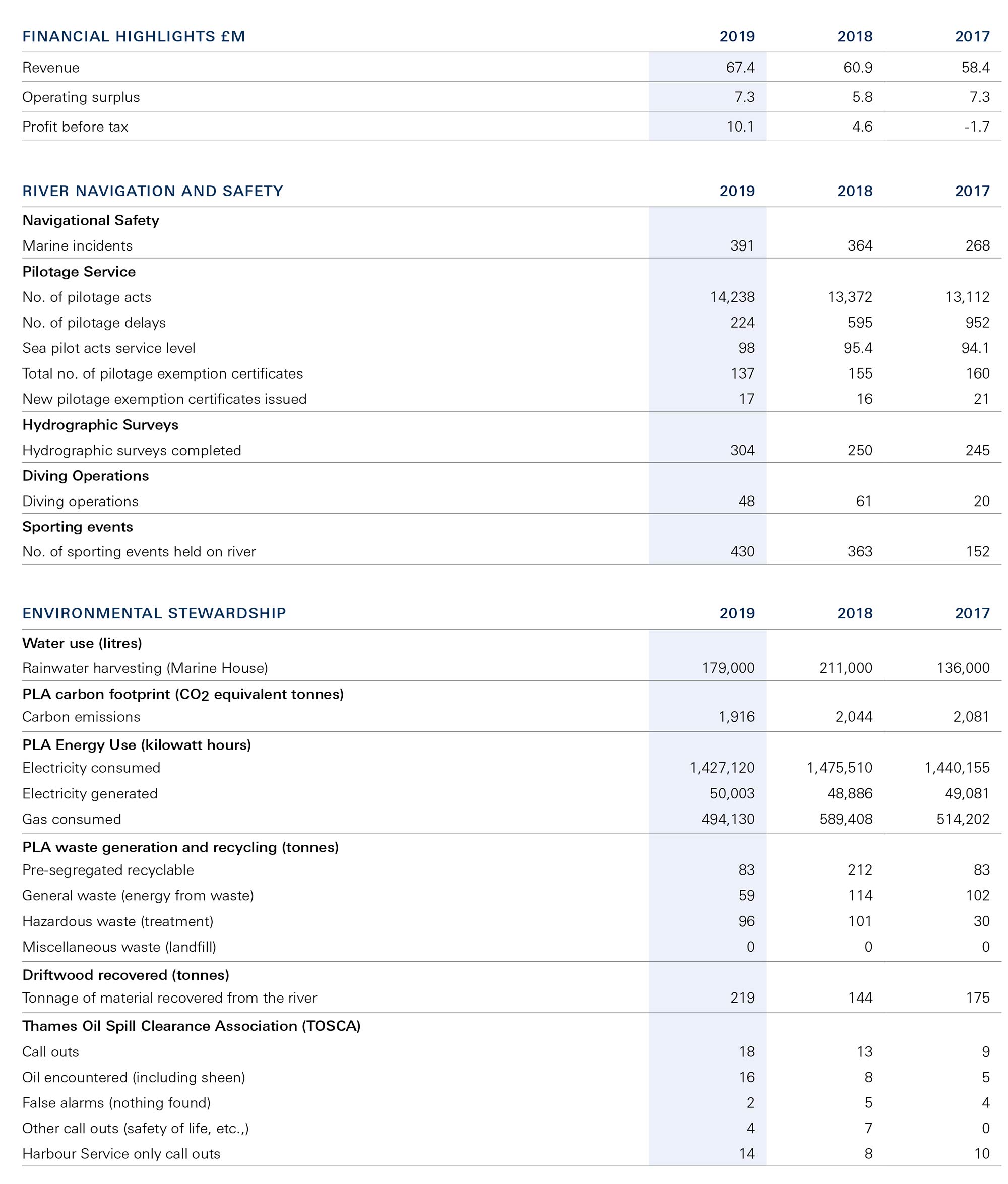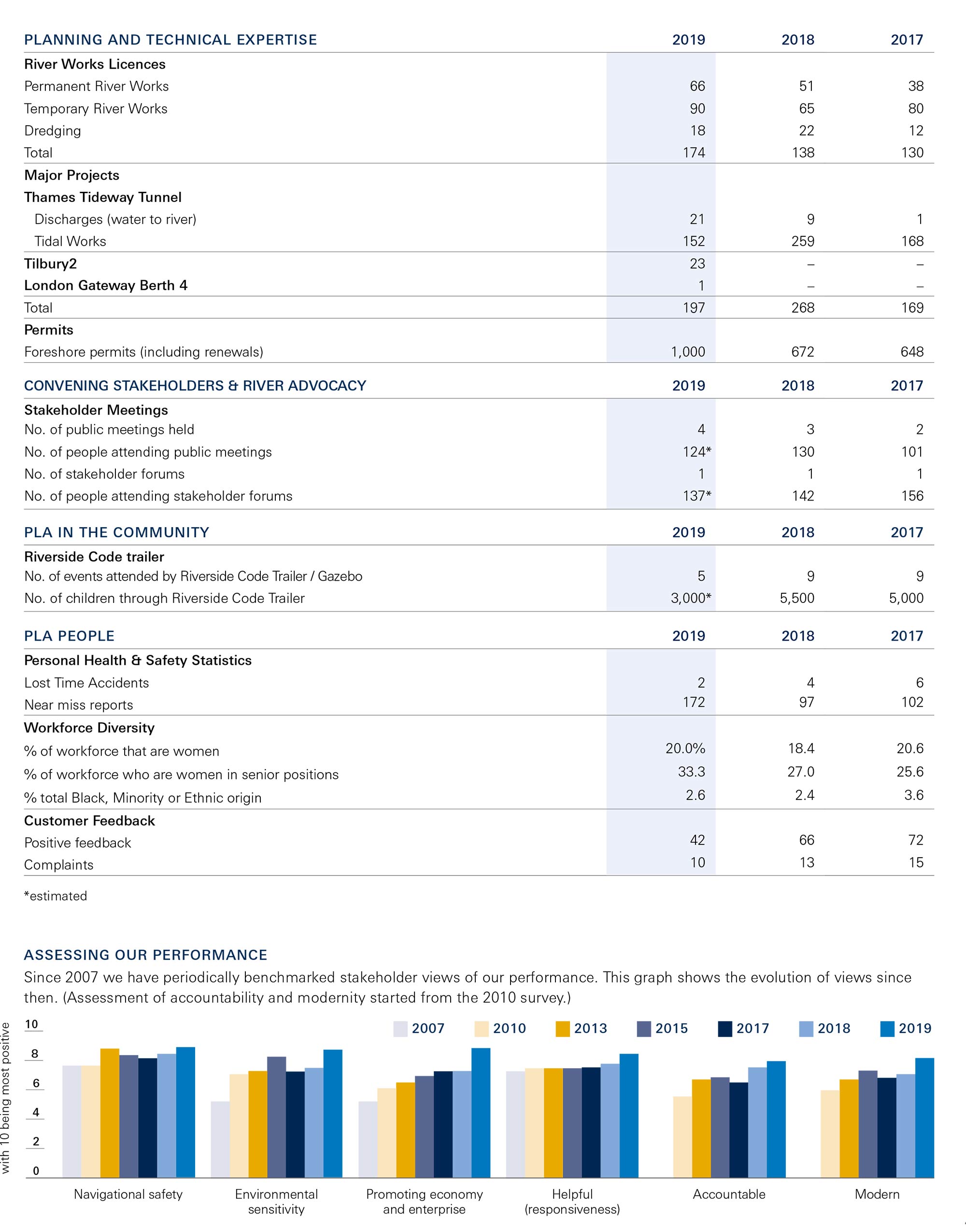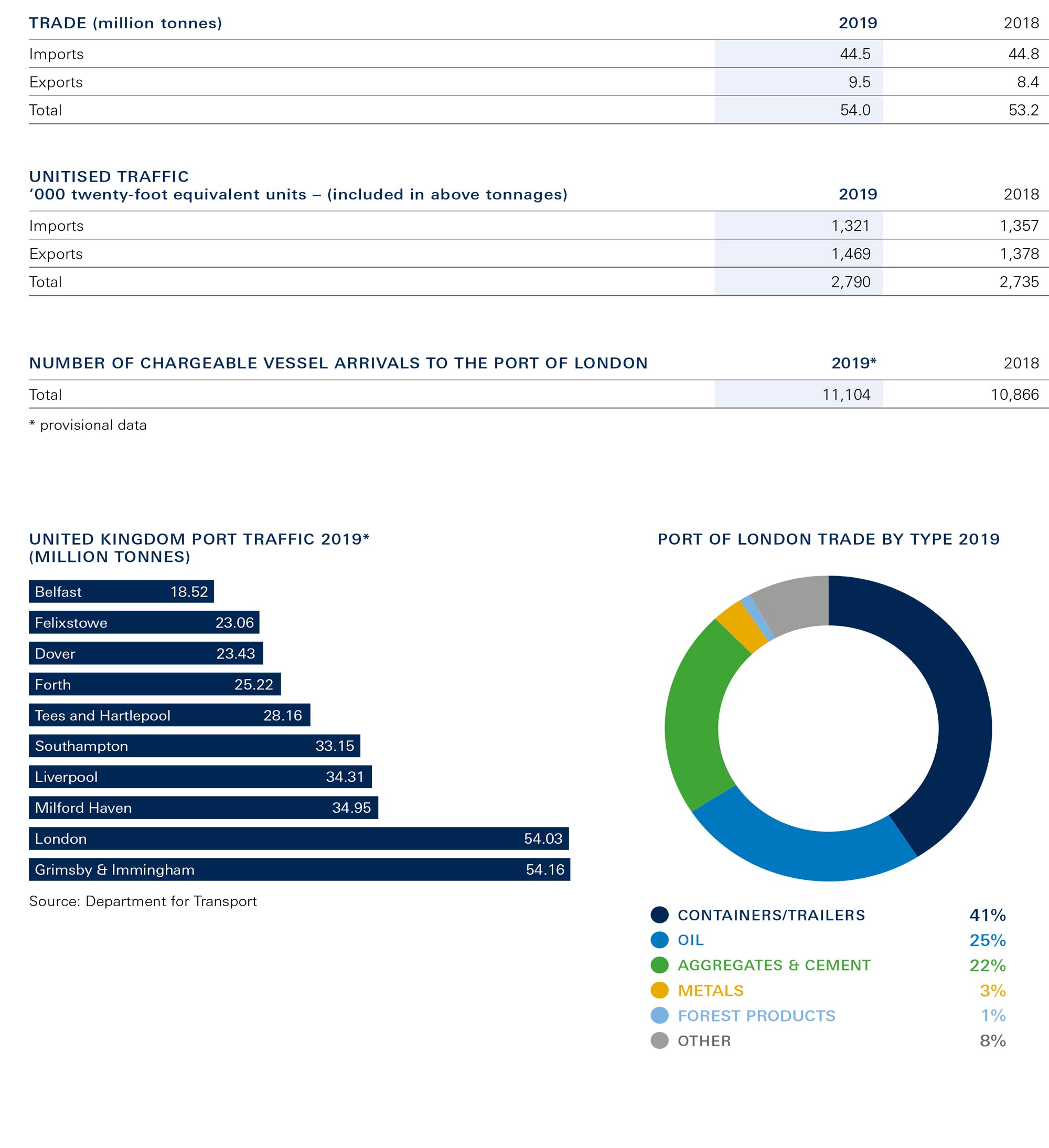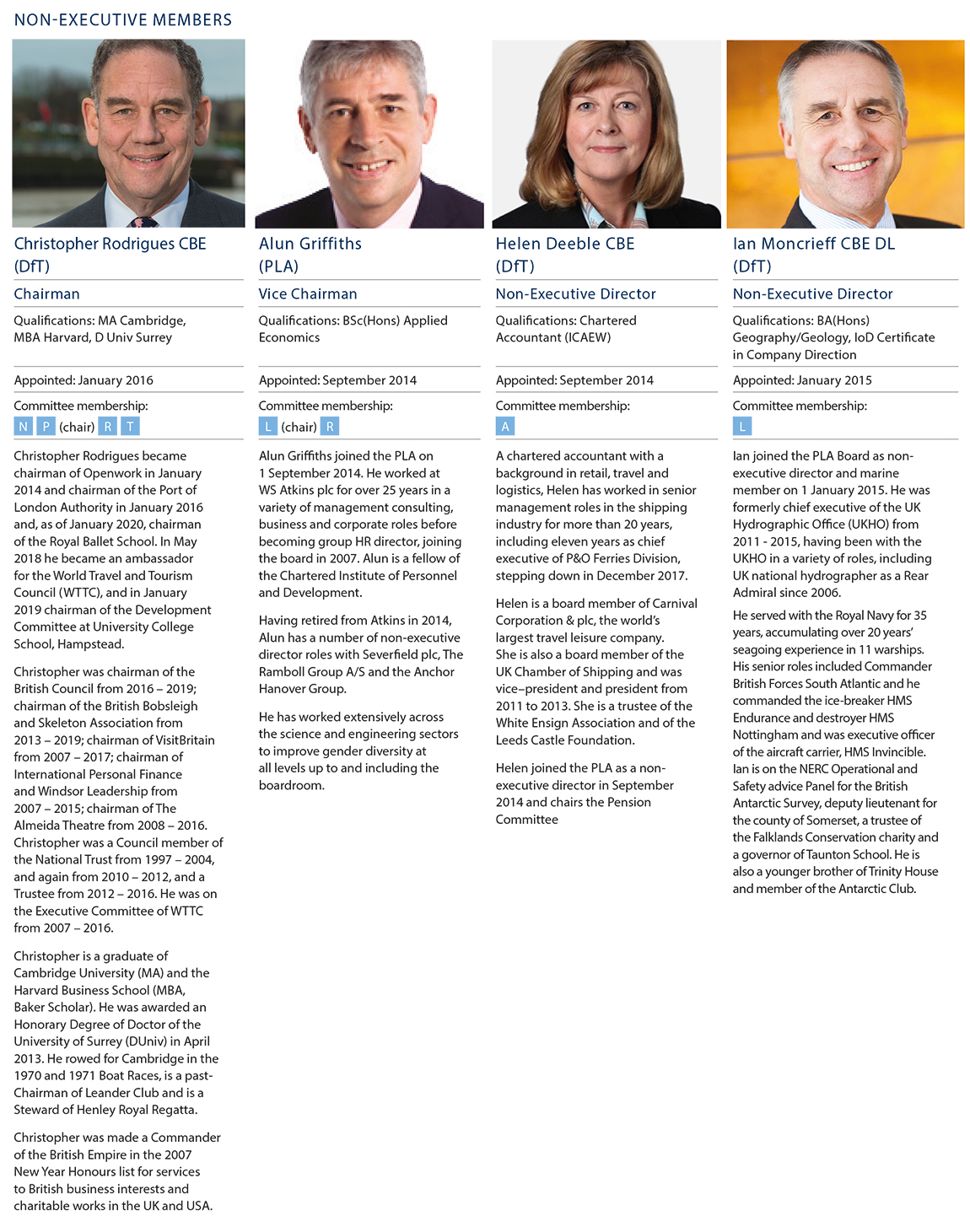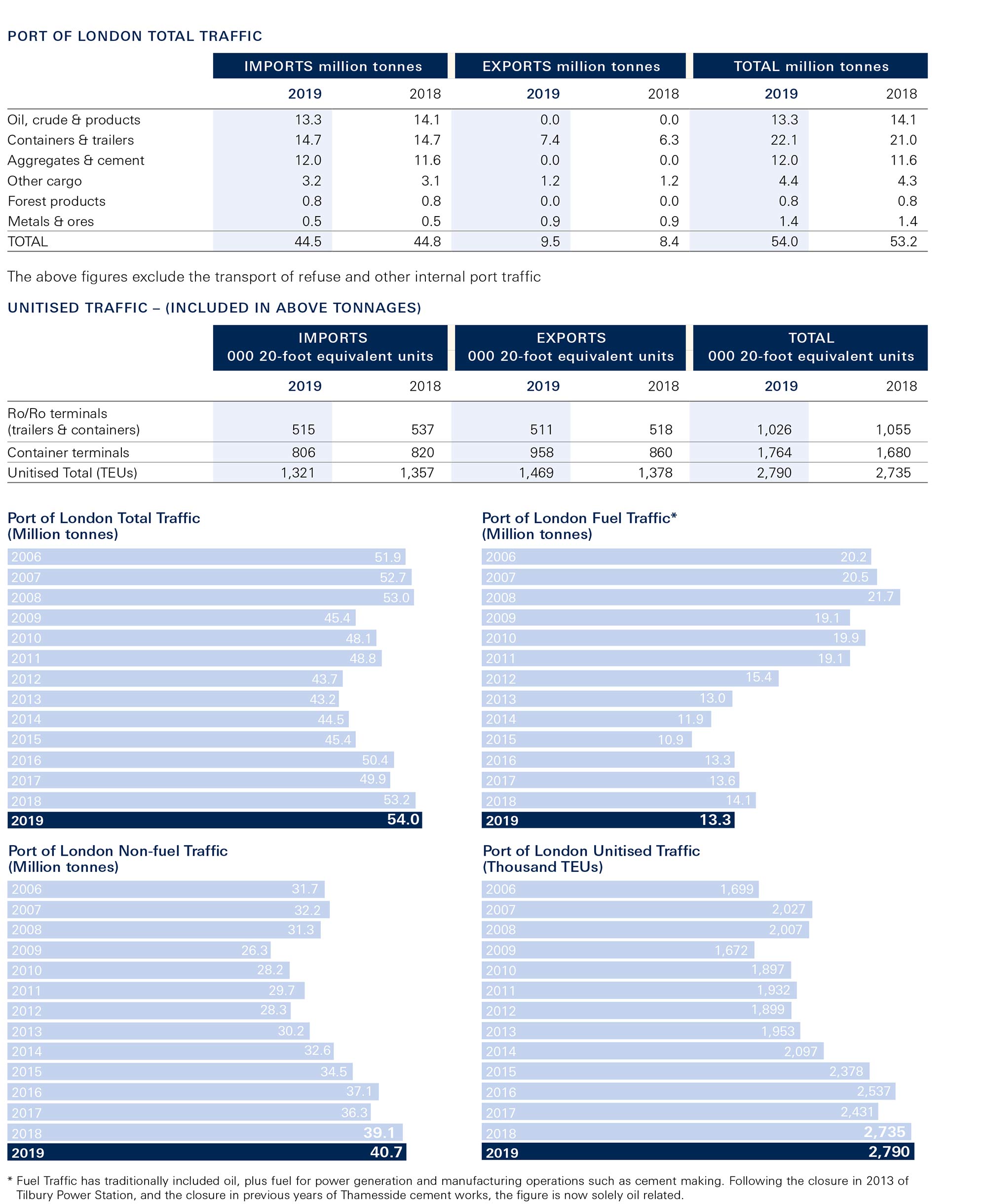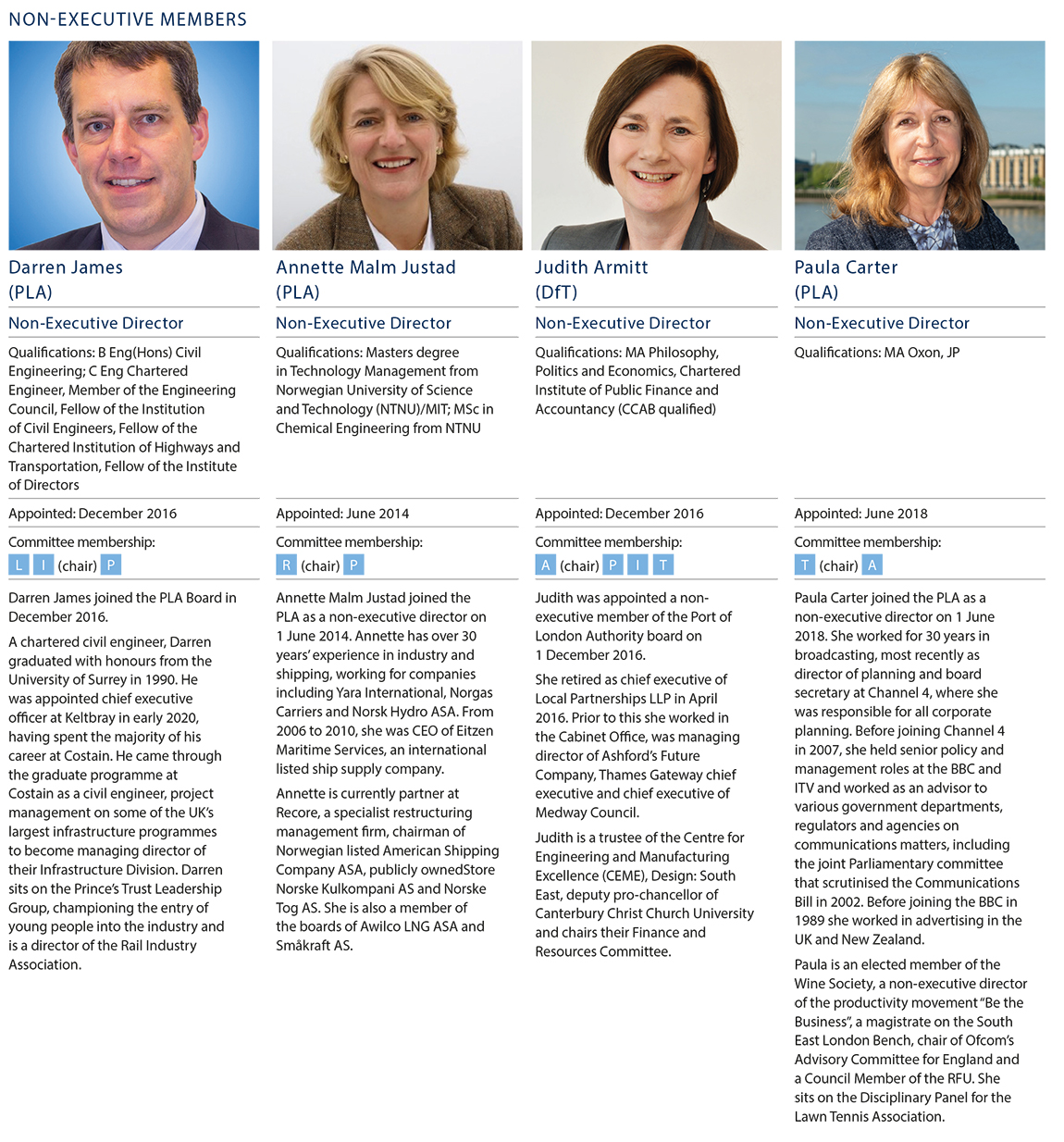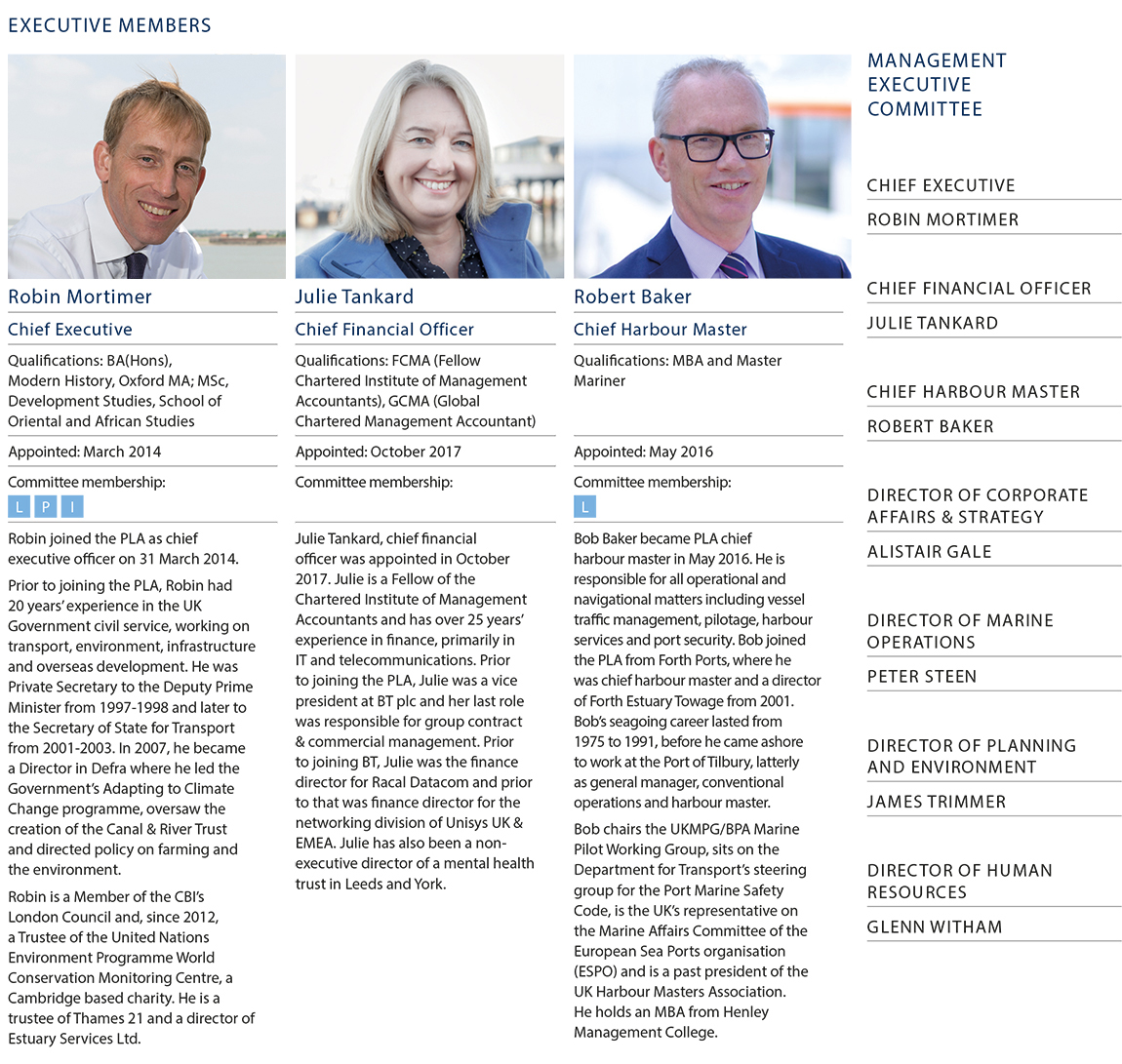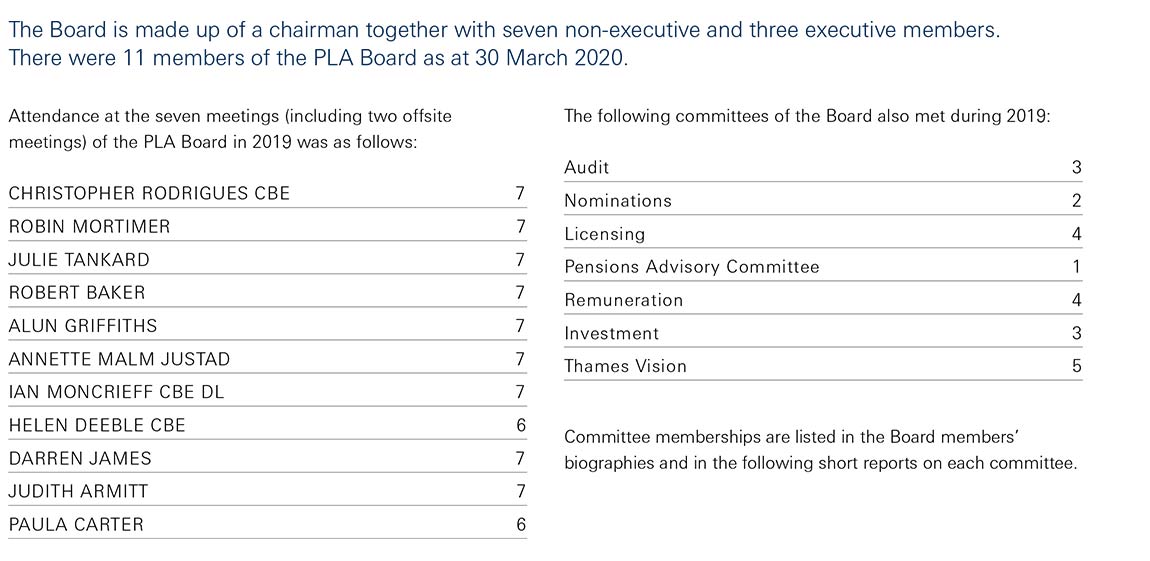Contents
Overview | Strategic Report | Business Model | Performance | Governance | Financial Statements
Coronavirus – COVID-19
This Annual Report & Accounts has been prepared in the early months of 2020, which has seen an unprecedented global response to the outbreak of the coronavirus, COVID-19. At the time of writing it is difficult to predict the long-term impact this will have on society, the economy and the river community that we serve. However, we are financially resilient. We have prepared a sensitivity analysis of our business and analysed our cashflow. Having assessed the potential for bad debts we believe that our business will survive this pandemic, if necessary through borrowing and using government financial assistance as a last resort. This document consequently focuses on reporting the outcome of 2019, and the position of the company at the time of signing, with some commentary on the coronavirus in outlook and risk sections.
OVERVIEW
ABOUT THE TIDAL THAMES
The tidal Thames is 95 miles of river from Teddington Lock, through central London, out to the North Sea. The river is home to the UK’s second biggest port, the busiest inland waterway for freight and passengers and a growing centre for sporting activity.
The tidal Thames is also a thriving habitat, home to 125 different species of fish, 3,000 seals and more than 300,000 overwintering birds.
Economically, the port plays a key role as part of supply chains serving the UK markets of London, the south east and beyond. Over 40,000 jobs depend on the port, which generates more than £4 billion in economic value added annually. In addition, there are over 100,000 jobs related to the river as an amenity and economic activity generating a value added of over £2 billion.
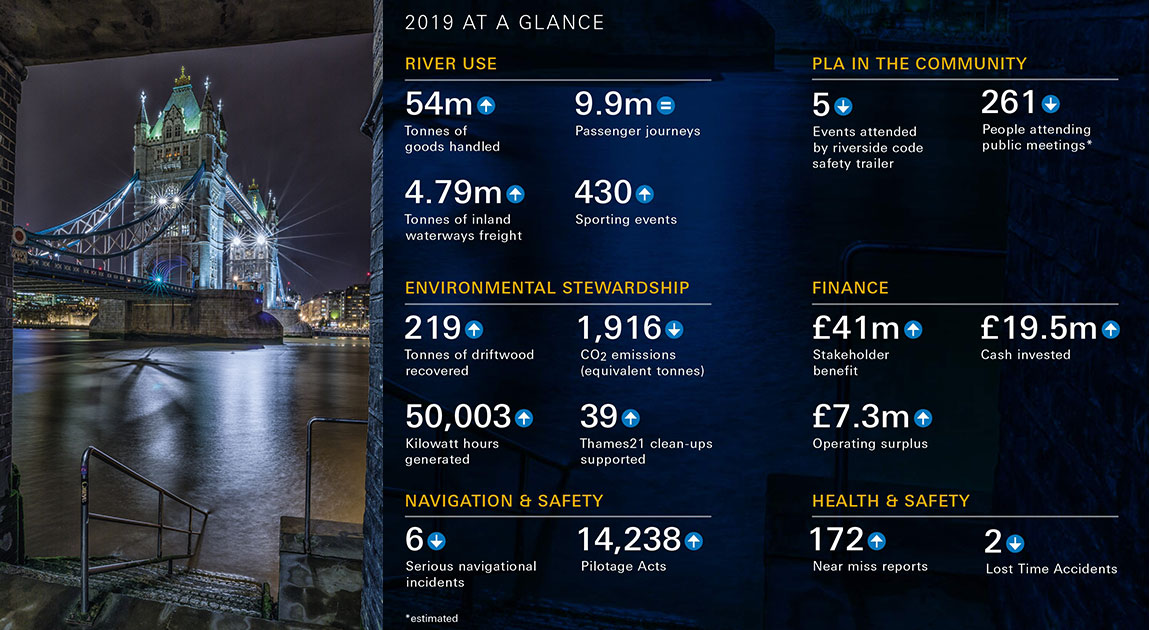
Image: Bob Walsh Thames Lens Competition Overall Prize
|
ABOUT THE PLA
At the Port of London Authority we are the Custodians of the tidal Thames. We hold the river in trust, working to hand it on in a better condition to future generations and realising the goals of the Thames Vision.
Our strategy to achieve this is centred on key themes of:
About the Thames Vision
The Thames Vision is a 20-year development framework for the river, created with stakeholders over 18 months from early 2015 to mid-2016. Across six goals, the Vision targets greater river use, alongside an improving environment. The Vision is being delivered in partnership by the PLA and stakeholders; key elements of the Vision are reflected in the London Plan and the Mayor of London’s environment and transport strategies.
The six goals for the Thames Vision 2035 are:
-
The busiest ever Port of London, handling 60 – 80 million tonnes of cargo a year.
-
More goods and materials routinely moved between wharves on the river – every year over four million tonnes carried by water – taking over 400,000 lorry trips off the region’s roads.
-
Double the number of people travelling by river – reaching 20 million commuter and tourist trips every year.
-
The river the cleanest since the Industrial Revolution,
-
with improved habitats and awareness of heritage.
-
Greater participation in sport and recreation on and alongside the water.
-
A riverside which is a magnet for ramblers, historians, artists and others, whether living nearby, on the river or travelling from further afield.
2019 HIGHLIGHTS
STRATEGIC REPORT
CHAIRMAN'S STATEMENT
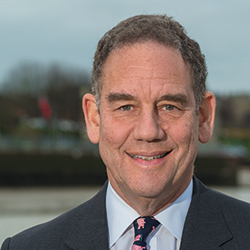 Chairman Christopher Rodrigues CBE Chairman Christopher Rodrigues CBE |
In 2019 we marked 110 years since the Port of London Authority (PLA) was created. That period has seen the river and country we serve evolve and respond to challenges many times over. This includes the two World Wars, during which the London docks played a crucial part and our former colleagues were on the frontline in keeping the nation fed and supplied. In 2020, we face a new and pressing global challenge, unprecedented in peacetime, as we manage our response to the coronavirus.
The breadth of the difficulties we face in dealing with the spread of the coronavirus has become increasingly clear since the turn of the year. Our teams play an essential role in the supply chains serving people across London, the south east and more widely; we are rising to the challenge of sustaining these critical links. Steps are in place to help keep our people healthy and safe, protect and support our core operations, and sustain the financial health of the organisation.
The challenges ahead of us are likely to be broad in scope, with operations and finance foremost. They are challenges we are prepared to face, with a well-trained and dedicated workforce and a balance sheet rebuilt over the last five years. While the momentum we had been building through that time has been impaired, as we work through the implications in the coming months our core strategic intent will remain to Protect, Improve and Promote.
We are advancing long-term projects centred on renewal so that we are fit for the new future. These include a Harbour Revision Order to modernise the provisions of the Port of London Act.
Responding to climate change is very firmly on our long-term agenda too. This is also set to prompt economic and environmental transformation as we move towards Net Zero emissions. We are determined to be in the vanguard of this change and last year convened London’s first Greening Inland Shipping conference and exhibition to help the debate on the Thames. Five years on from asserting custodianship of the tidal Thames, convening the event showed us well embarked on delivering on all that custodianship means.
Our short-term focus is responding to the coronavirus crisis, maintaining and enhancing the capabilities needed to protect our essential role in supply chains. For the longer term, the outcome of the virus and response to it remains unclear. We are ready to absorb and respond to the changes that may result, both in society and the economy.
My thanks on behalf of the Board to everyone in the PLA team, coming together as it always does, to make an essential difference at a time of great challenge for the nation.
Christopher Rodrigues CBE
15 April 2020

Images: Left: Staff gathered at London River House to mark 110 years since the creation of the PLA. Right: Young Thames trainees onboard sailing barge Blue Mermaid.
|
CHIEF EXECUTIVE'S STATEMENT
 Chief Executive Robin Mortimer Chief Executive Robin Mortimer |
Our 2019 review is written in early spring 2020, as teams across the PLA come together to address the significant operational and financial challenges posed by the spread of the coronavirus. We have measures in place to protect our core operational teams including pilotage, port control, marine services and Richmond Lock and Weir and provide the support services they need. We are also making contingency plans in order to continue to provide our key services, which maintain supplies of food, fuel and other necessities, that we all rely on.
The remainder of my statement relates, as appropriate in an Annual Report, back to 2019 when it was “business as usual” across the Port. We achieved a strong safety, commercial and financial performance in 2019 as we continued investing in the river and the PLA, working to deliver the long-term goals of the Thames Vision. A healthy financial position is an essential foundation and underpins our response to the current coronavirus outbreak and its long-term economic impact.
GROWING PORT
Port trade rose to 54 million tonnes in 2019, consolidating the rapid gain made the prior year, when trade increased to 53.2 million tonnes, and fully consolidating our position as one of the UK’s top two ports. Inland waterways freight was 4.79 million tonnes, an 82% increase on the 2.63 million tonnes moved by river in 2018, as three of the four principal Thames Tideway Tunnel tunnelling drives were active.
Continued investment at terminals on the Thames underpins the long-term forecast growth in trade volumes. DPWorld London Gateway continued to attract new trades, with six new services starting, providing links to destinations in the Baltic, Caribbean, Chile, East India and West Indies. A multi-million-pound contract tender exercise was completed in 2019 for the design and construction of Berth 4, which, once developed, has the potential to further increase London Gateway’s capacity.
Forth Ports made exceptional progress with its new Tilbury2 project, starting construction within days of being granted the Development Consent Order. The new facility is fully let to blue chip customers, P&O Ferries and Tarmac. Operations on the site are due to start this spring and this is expected to strengthen Tilbury’s resilience in the current coronavirus emergency.
In other trades, Oikos completed the second phase of its £64 million Project Aeris, which provided a new jetty and 12 new storage tanks at their Canvey Island site. Building material operators have continued to invest in their Thames operations. CEMEX has a new dredger close to completion and a new discharge facility at Northfleet – see PLA Investment Plan below – while Hanson followed improvements at its Dagenham depot with a major upgrade of its Victoria Deep Water Terminal under way.
CRO Ports continued investment at their Purfleet base, having upgraded jetties in 2018 to handle parent company, CLdN’s largest vessels. Two more new vessels entered service in 2019. CRO Ports’ multimillion-pound car deck development will be completed this spring, adding another 8,800 car parking spaces for their car handling business. Investment in systems and resources enabled them to secure full AEO (Authorised Economic Operator) Compliance and Safety & Security accreditation as part of ongoing European Union exit preparations.
For the river more broadly, the giant machines digging the main tunnel for the Tideway project reached the halfway point: 12.5 km of the 25 km total length. This is a major feat of engineering, not just tunnelling under the river, but building new pieces of land in the Thames to work in and digging giant shafts up to 50 m deep below London. Once complete, we will be able to enjoy a cleaner river, seven new areas of public space created along the Thames and the potential to bring wharves currently being used for the project back into long-term river use.
The number of passenger trips on the Thames remained stable at ten million. Among developments which will underpin future services, the new £5.7 million Royal Wharf Pier opened, and Thames Clippers added the biggest-ever boat to their fleet. Transport for London published their Pier Strategy and, early in 2020, announced plans for a ferry between Rotherhithe and Canary Wharf. We also commissioned ARUP to study the scope for continued growth in passenger travel on the river, the findings of which will be published later this year.
CUSTOMER SERVICE
The year saw improving levels of service in our pilotage operation, the result of consistent, focused investment and innovation over the last four years. 2019 was the first full year of a range of changes introduced in 2018, which included a new working agreement for pilots and an automated pilot allocation tool, alongside the ongoing programme of recruitment and training. Consequently, the service kept pace with continually growing demand, handling over 14,000 pilotage acts – 10% up on previous year – with a service level above 98%.
In other areas of service provision, our licensing team processed virtually all license applications within the statutory service time, with a service level of over 99%. In our annual assessment of customer service, we achieved a Net Promoter Score of 13, up from seven the previous year.
FINANCIAL PERFORMANCE
We delivered a healthy financial performance in 2019, with an operating surplus of £7.3 million (2018: £5.8 million) on a turnover of £67.4 million (2018: £60.8 million). The increased operating surplus principally flowed from increased port trade income and a revaluation of investment property. This positive performance helps sustain our long-term Investment Plan and wider programme of support for greater river use.
INVESTMENT
Major progress was made with the PLA Investment Plan, which we launched in 2018. A new vessel discharge system was completed for CEMEX at Northfleet, Peruvian Wharf officially reopened and the adjacent Royal Primrose Wharf was acquired.
Together, these two wharves give us a strategic landholding in East London comprising just over five hectares of riverside land. The Brett Group are operating a new concrete batching facility from Peruvian, taking lorries off the road in bringing marine dredged aggregate into London. Operators have also been selected for the development of Royal Primrose, following a competitive tender process.
The financial returns from projects such as these enable us to fund schemes which generate wider stakeholder benefit, such as the RSPB habitat improvement programme in South Essex and North Kent.
We also continued to invest in our operational assets. The principal investment was starting the work to refurbish and modernise our main Gravesend headquarters. Some 30 years since the building was opened, the programme will see life expired services (including air conditioning and electrical wiring) renewed and space reconfigured for modern working. Additionally, Richmond Lock & Weir was repainted as it marked 125 years of operation and a new radar tower built and operational at Northfleet.
SAFETY
Marine safety on the river improved further, with the number of serious marine incidents down from nine in 2018 to six in 2019. This was ahead of the 10% a year improvement target in our Marine Safety Plan.
On personal health and safety for PLA staff, there were two Lost Time Accidents in 2019, down from four in 2018. Staff also provided a record 172 hazard observation, or near miss, reports, after a concerted communications campaign at the start of the year. We are determined to make further progress towards our goal of zero harm for all PLA staff and contractors working on our sites. Any Lost Time Accident is one too many and it is my strong and ongoing commitment to continue a relentless focus on this across the organisation.
SUSTAINABILITY
As the port with the first Air Quality Strategy in the UK, we have invested in an extensive network of monitoring stations to assess the potential impact of cruise ships mooring at Greenwich Ship Tier. We also welcomed the arrival of the first hybrid pilot cutter, Leader, just as the year closed. This investment in innovation is a practical demonstration of the commitment we made in convening London’s first Greening Inland Shipping conference and exhibition in the late summer. This brought together river operators, technology providers and researchers in a unique forum which raised the collective understanding of the opportunities, challenges and next steps to be taken.
Our operational carbon footprint declined marginally to 1,916 CO2 equivalent tonnes in 2019 from 2,042 CO2 equivalent tonnes in 2018. Our focus this year is to develop a long-term plan to bring the PLA to Net Zero, in line with Government targets.
LOOK AHEAD
Our immediate focus is on addressing the challenges posed by the coronavirus outbreak and the global response to it. These include sustaining our essential services while ensuring our employees are kept safe and close financial management in the face of a radically transformed economy. We expect to delay a number of non-safety critical capital investment projects until the position is clearer. We are also keeping in close touch with our customers as they manage the economic impacts on their businesses.
In the long term, the challenge of ensuring that growth, when it returns, is sustainable will be key after the UK became the first country in the world to set itself a legally binding target to reach Net Zero greenhouse gas emissions by 2050. This will be a major focus of our work going forwards and we will be scoping what a Net Zero PLA and Port of London looks like and how we deliver it.
CORONAVIRUS
It is my privilege to lead a dedicated team at the PLA, never more so than now as together we continue operating as part of global supply chains, ensuring that families across London and the south east receive essential supplies through this very challenging time for all of us. Thank you to all PLA colleagues, customers and wider stakeholders as we pull together as a port and river community.
Robin Mortimer
15 April 2020
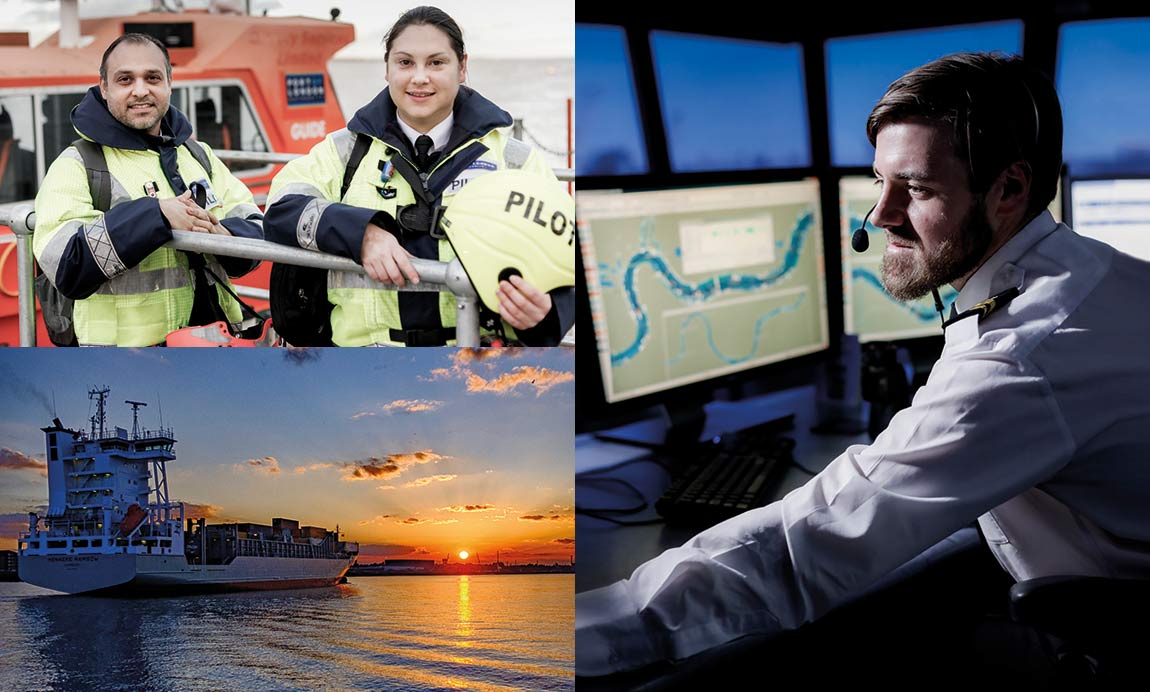
Images: Top left: Investment in training pilots underpinned a progressive improvement in customer service levels. Bottom left: Port throughput of 54 million tonnes makes London one of the UK's two major ports. Right: Port control at the heart of our marine safety systems.
|
CHIEF HARBOUR MASTER'S STATEMENT
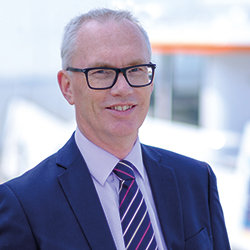 Chief Harbour Master Bob Baker Chief Harbour Master Bob Baker |
There were six serious marine incidents on the tidal Thames in 2019, down from nine in 2018. This performance is well ahead of the target in our Marine Safety Plan (2018-2020) to reduce the number of incidents by 10% every year.
This progressive reduction in incidents is testament to the rigours of our safety management system, efforts of all our staff and river users. We are far from complacent though, as the river will become more demanding as it gets busier. That is why we are working with the Company of Watermen on developing the first continuous professional development scheme for boatmasters on the Thames. This is one of the ways in which we are responding to incident statistical analysis leading us to focus our attention on the area with higher risk, identified as the upper river through central London.
Learning from incidents is essential and we aim to complete incident investigations in a timely manner. In 2019 the number of investigations completed within the target four-week period increased to 86%, up from 62% in 2018. This is an area on which we continue closely to focus.
Incident analysis drove our 2019 safety campaign which promoted the importance of maintenance to reduce incidents caused by breakdowns. We retained the focus on breakdowns for our social media posts during Maritime Safety Week as it remains an area of concern.
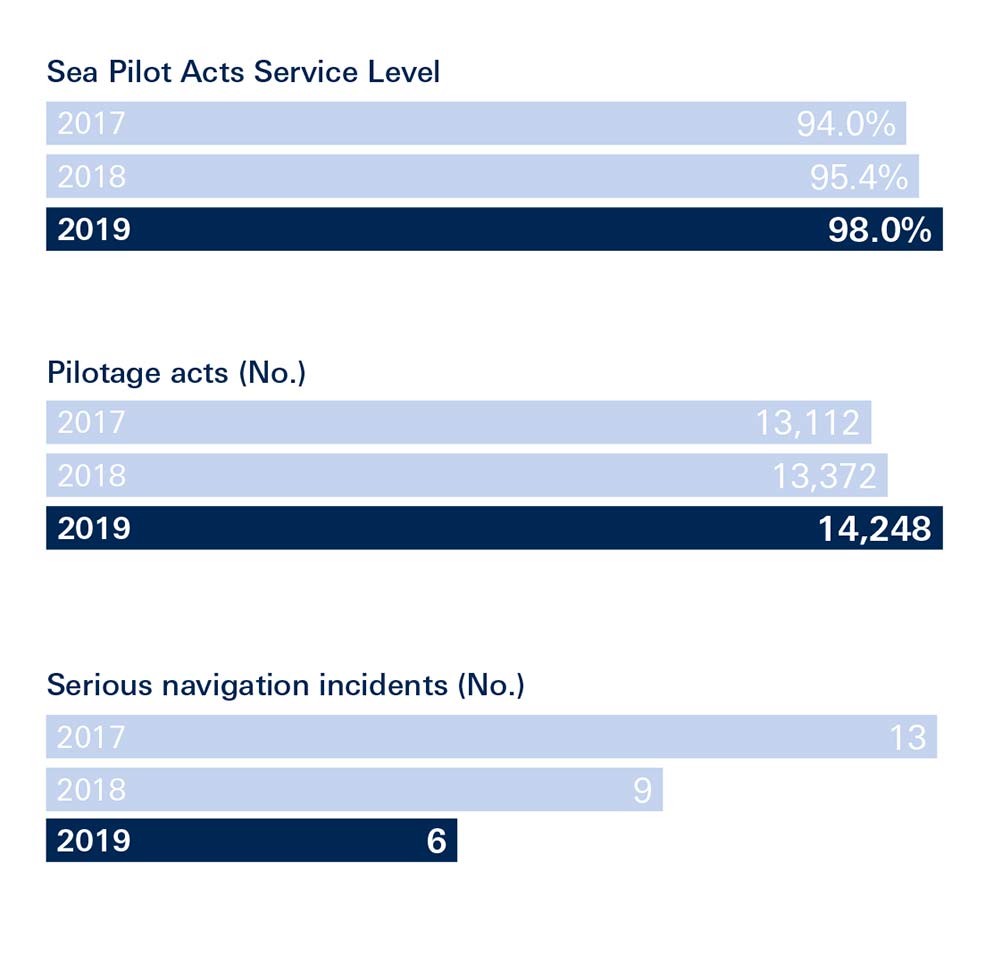
2019 saw a record 14,238 pilotage acts (2018: 13,372). This reflected continued growth in trade, particularly again at London Gateway as they secured new services.
We are now completing around 2,500 more pilotage acts every year than we were in 2015. The reliability of the pilotage service is markedly better than at the start of that period as continued investment in new pilots, management systems and the efforts of all in the pilotage department have borne fruit. The 2019 pilotage service level was in excess of 98%.
Investment in pilotage continues, with a further 12 pilots set to join us this year and a steady number now reaching Class 1, able to handle the largest ships. Alongside investment in people, our essential safety infrastructure continues to be improved too, with the new Northfleet radar entering service in 2019, providing better visibility across one of the busiest reaches on the river.
In the autumn of 2019, hearings were held into the charge brought against us, and a number of other defendants, by the Maritime & Coastguard Agency related to the sinking of the tug, Chiefton off Greenwich Pier in 2011 in which crew member, Darren Lacey tragically lost his life. The case concluded with the PLA found not guilty on all counts.
More detailed information on our safety work can be found in the River Navigation section of this Annual Report.
Bob Baker
15 April 2020
CHIEF FINANCIAL OFFICER'S STATEMENT
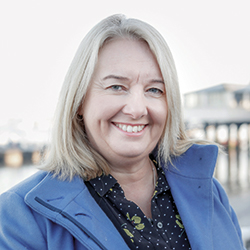 Chief Financial Officer Julie Tankard Chief Financial Officer Julie Tankard |
2019 was a healthy year for the PLA financially with trade up 1.6% by tonnage. We generated an operating surplus of £7.3 million (2018: £5.8 million) on a turnover of £67.4 million (2018: £60.8 million). Overall profit after tax was £10.3 million (2018: £3.5 million). This solid outcome is positive as we work to respond to the challenges posed by the coronavirus outbreak in early 2020.
The increase in year-on-year operating surplus was mainly related to increased port trade income. A revaluation of investment property added a further £4.1 million to the surplus and we also benefited from a tax rebate relating to property-related insurance claims.
We continue to hold sufficient cash and adequate reserves to service our long-term goals and reflective of our long-term liabilities. In the immediate future our focus will be on protecting this position as we work to maintain our core services and start to deal with the economic impacts of the coronavirus outbreak which is likely to involve bad debt provisions.
In 2019 we continued the focus on improving the customers’ experience, specifically in the pilotage service. We have made substantial and ongoing investment in pilotage over recent years, responding to the growth in ship calls, particularly at London Gateway. To reflect these increased costs, and to ensure the service did not become loss making, we took the one-off measure of increasing 2019 pilotage charges by 1% more than the increase applied to other charges.
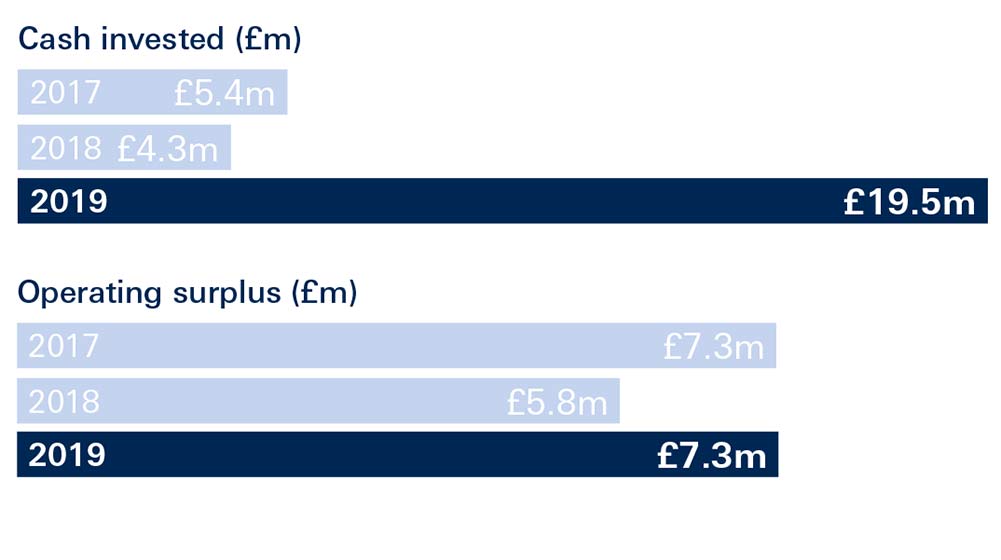
Pilotage income for the year was £25 million (2018: £22.5 million); after costs, pilotage made a small, £0.02 million contribution to the year’s overall operating surplus. For 2020, we have made a further change to charges for larger vessels (365 metres and above) to reflect the higher costs of servicing these vessels, which require two pilots.
Rental income continued to grow to £11.7 million in 2019, (2018: £9.9 million), this is a key part of our strategy to diversify income. It reflects both market-related river works licence income rises and rent from investment land where safeguarded wharves are returned to use. Income from the diving, salvage and hydrographic support service we provide grew to £6.2 million in 2019 (£5.9 million in 2018), largely due to successful completion of hydrographic contracts.
Operating costs were higher as a result of the operating payroll being 9% higher than the previous year, as we added more pilots to support growth in business and undertake more activity to serve customers. Increases in third party supplies and services related to the boarding and landing of pilots, and the contractor costs involved in the delivery of hydrographic contracts.
We continued to strengthen the balance sheet, growing the assets and reducing the liabilities. An additional investment property was acquired in 2019 which is a continuation of the Investment Plan launched in 2018.
The Investment Plan is a major initiative through which, in line with Trust Ports’ guidance, we support both commercial and public benefit projects. The first major commercial project, with CEMEX at Northfleet, was delivered in 2019 and is already generating income. Brett Group started operations at Peruvian Wharf during 2019, which is now also contributing increased rental income. Royal Primrose Wharf, adjacent to Peruvian, is in the process of being made operational, with some income already being generated.
Our main operational capital investments were in the purchase of a new hybrid pilot cutter for the Gravesend pilot transfer operations, as we started to focus on reducing the carbon intensity of our operations.
The principal building services for our Gravesend offices had reached the end of their operational life and substantial costs were set to be incurred in their replacement. We took advantage of this situation to re-scope the project, undertaking a major upgrade and refurbishment of the building which will provide an environment better suited to more flexible, cross team working, alongside the required new services. Improvements include reduced carbon intensity through the adoption of solar power generation and lower energy facilities.
Our pension obligations remain a significant commitment; the overall deficit to the multiple schemes that we operate or participate in is £62 million, an improved position on last year. We continue to pay into the deficit repair plan for the main PLA Pension Fund and are ahead of the deficit repayment plan. After the Triennial valuation of the scheme, we agreed to maintain the existing deficit repair plan. During the year we added a further £4 million into the pension fund to offset any impact of the Guaranteed Minimum Pension (GMP equalisation) issue. Looking ahead, our approach is likely to be more conservative, considering the economic and financial impact of the coronavirus.
Managing the impact of the coronavirus is our immediate focus. Longer term, as the impacts of these exceptional times become clear, we will review our options to continue strengthening the business and diversifying our income through our Investment Plan.
Julie Tankard
15 April 2020

Images: Left: The Cemex jetty at Northfleet, the first major investment plan project completed. Right: DP World London Gateway, winning new services and looking at future growth.
|
OPPORTUNITIES AND CHALLENGES
We manage and respond to a range of opportunities and challenges. The full array of factors we address through our risk management process is detailed in the Governance section of this report. This section sets out our headline view of key opportunities and challenges.
OPPORTUNITIES
Increasing all aspects of river use through the six goals in the Thames Vision is the biggest opportunity for the PLA. The Vision provides the framework for us to work with stakeholders to achieve our shared goals for the Thames. Four years on from its launch, we are set to embark on the first review of the Vision to ensure that it is in line with changes in stakeholder expectations, and developments in the economy and society that we serve.
In line with Vision forecasts, port trade growth is a major opportunity for the PLA. Investment by operators including DPWorld at London Gateway and Forth Ports at Tilbury has underpinned substantial and ongoing growth in trade. That investment looks set to continue as terminals and operators respond to opportunities that emerge from serving the UK’s largest consumer market.
The PLA-convened Port of London Infrastructure Group supports port trade growth, drawing together operators, Government and infrastructure providers in a forum for dialogue around the infrastructure needed to support the growing port.
In the longer term, the Government’s proposals for freeports represents a potential major opportunity. We are supporting operators of terminals on the river to develop a Thames Freeport proposal.
Our Investment Plan is supporting growing river use through commercial projects which will secure existing, or generate new, tonnage at Thames terminals. The holistic Plan embraces commercial opportunities; deals with longer term payback projects which generate wider stakeholder benefit; and schemes which improve the river’s amenity.
The Thames Tideway Tunnel provides both opportunities and challenges. The principal long-term benefit of the scheme is a substantially improved marine environment. Already the project’s use of the river in its construction phase has prompted investment in vessels, tugs and barges and the embedding of higher standards of marine operations on the river, a legacy for the future.
Increased use of the river for river freight and passenger services means more skilled people are needed to work on the river – and that the skills of existing workers are maintained and improved. We have helped meet this demand through the training opportunities offered by the Thames Skills Academy, the Company of Watermen & Lightermen and Thames operators themselves. This is now to be supplemented by a new continuous professional development scheme we are developing with the Company of Watermen & Lightermen.
CHALLENGES
The most immediate and very substantial challenge in the early months of 2020 is the potential impact of the coronavirus, both operationally and economically. We have taken immediate steps to better protect our key operational staff from exposure to the virus, in order that our essential port control and pilotage services can be maintained. It is too soon to understand the likely economic impact of the virus and global response to it; it is a situation we are monitoring and will respond to as it becomes clearer.
Political, economic and operational uncertainty over arrangements for the UK to leave the European Union remains a key challenge. We continue to plan for the possible implications, follow developments closely and support Thames operators as they prepare for the opportunities that may arise.
After several years in which air quality emerged as an increasingly important issue climate change is now very much centre stage. The Government’s commitment to achieve Net Zero emissions by 2050 sets a clear framework. We have a major project underway to scope the likely changes, challenges and opportunities that flow from the legally binding target and it was the focus of our best-attended annual Environment Conference at the start of 2020.
A particular challenge for the port is the likely switch from fossil fuels for transport, which is expected to impact on the volumes of fuel passing through the port. Such a change and transition to new cargoes could provide marked financial challenge.
We are delivering the Action Plan commitments made in our Air Quality Strategy, which will be subject to its first annual review in 2020.
Demand for our pilotage services continues to grow. This means that consistently providing for the ‘on demand’ requirements of our customers can be challenging, particularly peak demand, which can be more than double average demand on the busiest days of the year. We manage this through ongoing investment in training new pilots.
This is a long-term endeavour as pilot training to unrestricted level takes four years.
One of the main challenges we have managed linked to the Tideway scheme is the operation of 12 construction sites in and alongside the river. The increase in barge movements has been overseen by our dedicated Tideway harbour master, harbour launch crews and navigation control. We structured our licensing team to manage the high level of consenting demands for the project.
Calls for river space to accommodate new crossings and new or expanded windfarms remains a challenge. We support the need for more river crossings in London as essential to continued economic development and engage in debate around specific proposals. Our priority is to ensure that proposals are compatible with an increasingly busy river and that the established rights of navigation are not impeded in a maritime city.
The drive to achieve Net Zero is expected to create a further drive to expand existing windfarms in the Thames Estuary, or develop new ones. With the Estuary a complex space, serving one of the UK’s busiest ports, such developments need careful consideration to ensure that they do not prejudice safe navigation. We engage actively on these proposals with both the developers, the shipping lines and terminal operators who would be affected.
Contents: Overview | Strategic Report | Business Model | Performance | Governance | Financial Statements | PDF format
BUSINESS MODEL
PLA STRATEGY
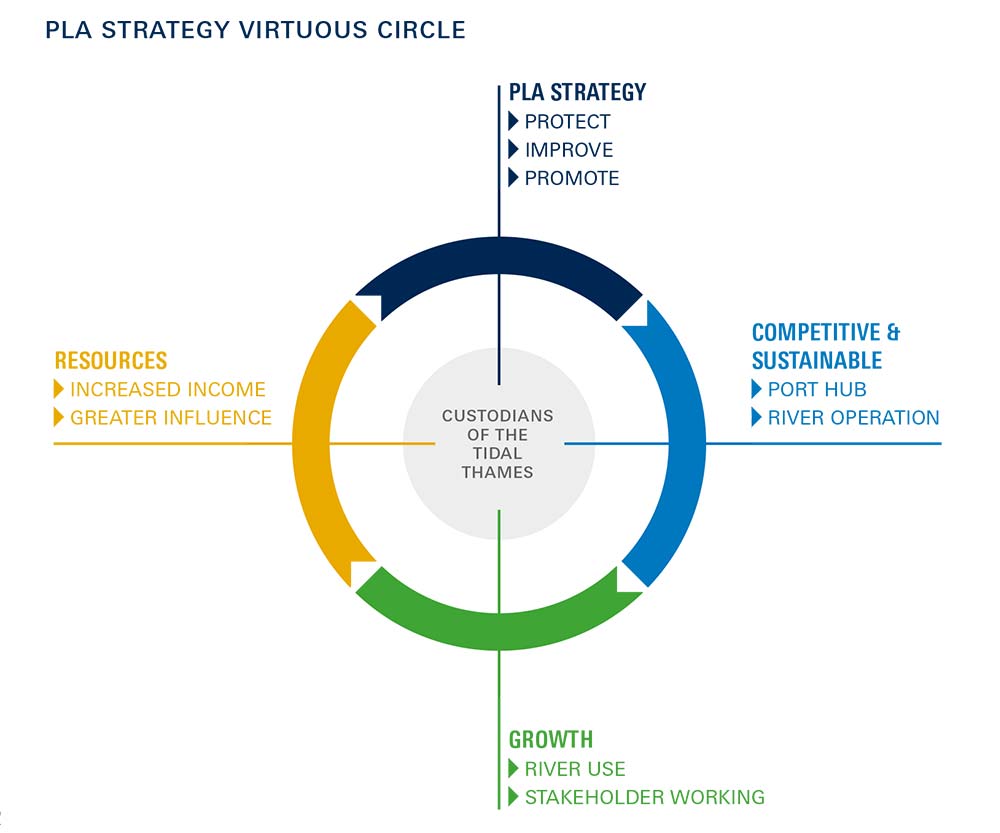
As a Trust Port, we hold the Thames in trust for future generations. We have no shareholders, so operate for the benefit of customers and stakeholders now and in the future.
The stakeholders’ ambition, as set out in the Thames Vision, is to see the river play a much greater role in the life of London and the south east, from trade and travel to sport and recreation. To support this ambition, our strategy is centred on three core roles for the PLA:
Protect
targeting Zero Harm and improved sustainability
Improve
running efficient operations and investing to support growing river use
Promote
leading the Thames Vision to unlock the potential of the Thames
The Thames is the UK’s busiest inland waterway and the Port of London is one of its busiest ports. The most recent assessment of the economic impact of port and river operations found a total of £6.4 billion Gross Value Added and more than 140,000 river-related jobs. Achieving the goals in the Vision will see this already substantial contribution grow further now and in the future.
A strong and effective PLA supports growth through creating the ‘virtuous circle’, shown below. Delivering on our commitments to Protect, Improve and Promote will help develop the competitiveness and sustainability of port and river operations. This will underpin growth in river use and generate a financial return, which we can invest again in protecting, improving and promoting.
STAKEHOLDER BENEFITS
As a Trust Port we provide stakeholders with a range of benefits, alongside discharging our specific duties. When asked in independent research, stakeholders identified our main contributions being in: river navigation and safety; environmental stewardship; planning consultation and technical expertise; bringing people together and promoting the river.
Over the last five years we have increased our river advocacy through the development with stakeholders of the Thames Vision. The Vision, launched in mid-2016, provides a framework for the river’s development over 20 years to 2035. We will be working with stakeholders through 2020 to review and update the Vision for an extended time period out to 2050, in line with the Government’s Net Zero commitment.
Our main contributions to stakeholders are, in more detail:
RIVER NAVIGATION AND SAFETY
Our port control centres, harbour masters, pilots and river patrol crews help keep river users safe. Our salvage operations and divers keep the river clear of obstructions and open for business. We are responsible for river traffic control and navigational safety, including buoys, beacons, bridge lights and channel surveys.
ENVIRONMENTAL STEWARDSHIP
We hold the tidal Thames in trust, with the remit to hand it on to succeeding generations in better condition. A major part of our work is conservancy of the Thames, dredging and maintaining the main navigation channels on the river. As stewards of the marine environment, we carefully look after the river’s many assets, conserving wildlife, keeping the river clean and free of rubbish. Over the last four years we have been working increasingly closely with stakeholders on improving air quality on the tidal Thames. We maintain the tow path, revetment wall and have an active tree management programme along a stretch of the Thames up-river of Putney. Promoting the use of the river as a natural, low-carbon transport route is a key activity too.
PLANNING CONSULTATION AND TECHNICAL EXPERTISE
We provide information, support and significant technical expertise to help river users and investors maximise the value of the river, and to do it safely. We license river works and dredging on the river, applying our expertise to keep river users safe and protect the environment.
BRINGING PEOPLE TOGETHER AND PROMOTING THE RIVER
We bring people together to discuss how to make the best use of the Thames and advocate its potential. We work with, and for, a wide range of stakeholders and partners on commercial freight, investment, property, safety, conservation, leisure, tourism, passenger transport, sporting pursuits and major events. We try hard to be a ‘listening’ organisation as well as one that delivers what our stakeholders need and want.
STAKEHOLDER BENEFIT
Set alongside the economic and amenity benefits that our operations underpin, we also generate a substantial benefit to the community, estimated to be £41 million in 2019 (2018: £36.7 million). Our major direct community contributions are to organisations including the Sea Change Sailing Trust and Tilbury Seafarers Centre; activities required for our core responsibilities such as making our archive publicly available at the Museum of London Docklands; and support for organisations like the Thames Skills Academy.
The development of the PLA Investment Plan has made available further funds to support increasing use of the river. In 2019, £15 million was spent across the three categories of the Investment Plan, most of which related to the acquisition of Royal Primrose Wharf which we acquired to safeguard for river use. More than £39 million is paid in taxes, wages and other employment costs which contribute directly to the local economy.
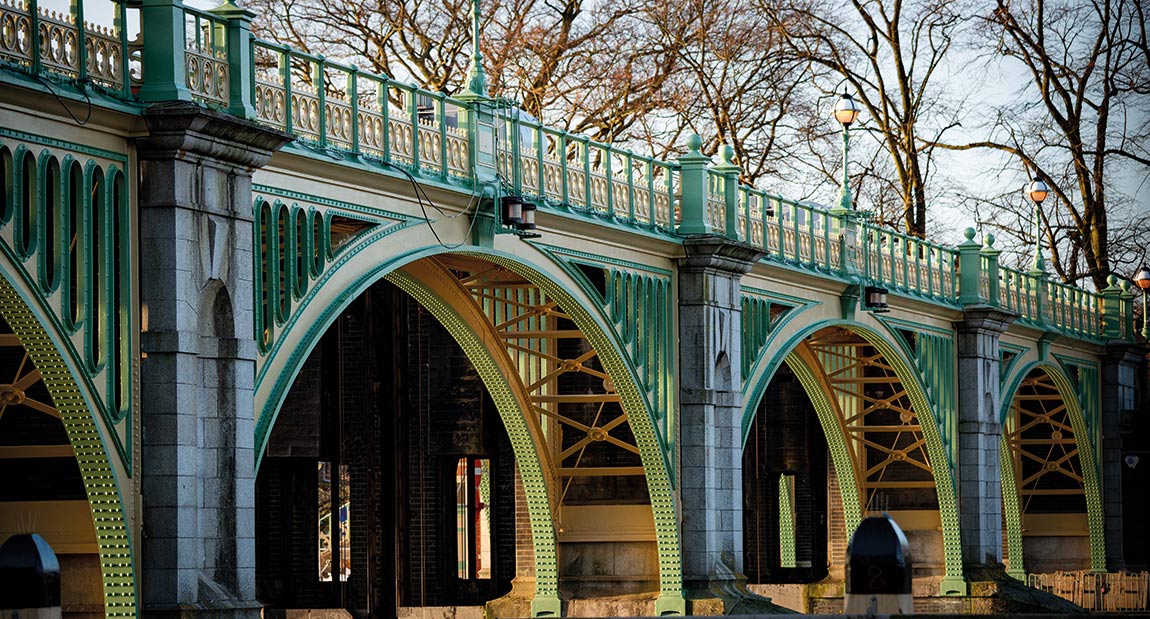
Image: Richmond Lock & Weir resplendent after its £500,000 repaint.
|
Contents: Overview | Strategic Report | Business Model | Performance | Governance | Financial Statements | PDF format
PERFORMANCE
RIVER USE 2019
PORT TRADE

Trade in the Port of London rose in 2019 to 54 million tonnes from 53.2 million tonnes in 2018. This meant we virtually tied with Grimsby & Immingham as the UK’s leading port in terms of tonnage of goods handled.
Unitised trades grew by 1.1 million tonnes on the prior year as throughput at London Gateway continued to rise. Oil products and gases fell 800,000 tonnes or 6% to 13.3 million tonnes. Tonnages of building materials (11.6 million tonnes), metals
(1.4 million tonnes) and forest products (0.8 million tonnes) were stable compared to previous years. Further detail on port trade is in the chief executive’s statement.
INLAND WATERWAYS FREIGHT

2019 saw 4.79 million tonnes of freight moved between terminals on the Thames, up from 2.63 million tonnes in 2018. The overall tonnage of materials moved increased 82%, as river use by major infrastructure schemes, particularly the Thames Tideway Tunnel, accelerated.
As the Tideway project reached the half-way point, its river use was at a peak, with the movement of a mix of cargoes: tunnelling spoil, tunnel lining segments, steel reinforcement and sand/gravel. The river also continued to enjoy the traditional strong baseload of movements of building materials, alongside waste to the energy from waste plant at Belvedere, with the resultant ash being transported downstream to the Port of Tilbury by barge for recycling into building materials.
The Brett Group and Keltbray established their respective operations at Peruvian Wharf, the safeguarded wharf in East London, during the year. The site is expected to handle up to 600,000 tonnes of materials annually, keeping more than 30,000 lorries off London’s congested roads. Work continues on longer term plans for the reactivation of a number of safeguarded wharves in the capital, including those in West London currently being used for the Tideway scheme.
PASSENGER TRAVEL

The number of passenger trips on the river remained flat in 2019 at 9.9 million. River tour operations enjoyed some underlying growth, while operational issues affected the Woolwich Ferry service as two new hybrid powered vessels came into service.
Transport for London (TfL) published their Passenger Pier Strategy, setting out plans for pier development over the medium term, around a set of eight principles, integrating with other forms of transport, environmental sustainability and safety targets. We also worked with TfL commissioning ARUP to undertake a passenger transport study to identify opportunities for growth and potential obstacles to progress. The findings will be released in 2020.
Investment continues in infrastructure and vessels. Royal Pier Wharf, the longest pier on the Thames, was opened at Silvertown, making river transport an option for new riverfront communities. Thames Clippers, who will call at the new pier, have added the largest vessel to date to their fleet.
Longer term, TfL are taking forward a ferry crossing project between Rotherhithe and Canary Wharf to improve connectivity. They are targeting environmentally friendly vessels and piers which will set new emissions benchmarks for the Thames and UK ports more widely.
SPORT AND RECREATION

The number of sporting events held on the river rose again in 2019 to 430, up from 363 in 2018. The increasing number of events reflects growing river use – a key target of the Thames Vision – alongside established marquee events such as the University Boat Races, Head of the River races and the Great River Race.
Thames Regatta, set to be a major new event on the Thames in 2019, was sadly cancelled due to extreme weather conditions. The event was developed through substantial investment from Tideway and we hope to see its inaugural running soon.
During 2019 we worked hard with London Sport to develop a concept which will support the long-term Thames Vision goal of greater sport and recreational on the river. Active Thames is the result, a programme which will address three key areas which can drive increased participation. Through 2020 we will be focused on securing the funding needed to deliver the programme.
RIVER NAVIGATION AND SAFETY
Our main responsibility is maintaining the Thames river channels and managing navigation along 95 miles of the tidal Thames, downstream of Teddington Lock. We use our Marine Safety Management System to review the hazards and risks to safe navigation and put measures in place to address them. These include navigation lights and buoys, hydrographic services, pilotage and Vessel Traffic Services control centres at Woolwich and Gravesend, which oversee safe navigation over 400 square miles.
2019 was the second year of our latest three-year Marine Safety Plan. The Plan features six targets aimed at reducing incidents year-on-year. Four of the targets were fully achieved, one partially achieved, and one not achieved. The principal target, reducing serious marine incidents by 10% every year, was achieved with just six recorded in the year (2018: nine incidents).
The progressive reduction in serious incidents on the Thames is the result of a continued focus on incident analysis and learning of lessons about what prompted them. This is essential as the river continues to get busier. To ensure improvement is sustained, we started work with the Company of Watermen & Lightermen to develop a new programme of continuous professional development for all those working afloat on the river, mirroring similar initiatives in the aviation, rail and construction sectors.
May saw HRH The Duke of Cambridge give his backing to the first Thames Drowning Prevention Strategy. Suicide remains the single most frequent cause of drowning in the Thames. Partners including the RNLI, Met Police, Maritime & Coastguard Agency and London Fire Brigade came together to develop the strategy which included a call for the public’s help in preventing accidents and self-harm incidents.
Our emergency preparedness work continued to ramp up through the year. This included a number of exercises, including one with live deployment of assets to a tackle an oil spill situation. To increase the realism and effectiveness of the training, this exercise included mock TV interviews and social media injects.
Recreational use of the river continues to intensify. In response
to this – and to make access to essential safety information easier – we combined two previously separate sets of guidelines for recreational users of the river to create: The Tideway Code – a Code of Practice for Rowing and Paddling on the Tidal Thames. It was produced with the support of the Thames Regional Rowing Council, British Canoeing and water sports clubs and organisations from along the 95-mile course of the tidal river.
Allied to provision of improved safety information we also prosecute to ensure there is a deterrent to unsafe behaviour. In line with this in April a jet skier who navigated at speed along the Thames towards central London in summer 2018 was prosecuted at Westminster Magistrates Court, fined £2,750 and ordered to pay costs totalling over £3,500 for ignoring the ban on jet skiing on the river in London.
Among the essential safety services we provide is the hydrographic surveying of the bed of the river. 2019 was our most productive year in terms of estuary survey coverage in over a decade, with the full safety of navigation survey programme completed. We are progressively extending our Electronic Navigation Chart coverage to the Thames Barrier and this coverage will extend further upstream to Greenwich and potentially the Lower Pool in 2020.
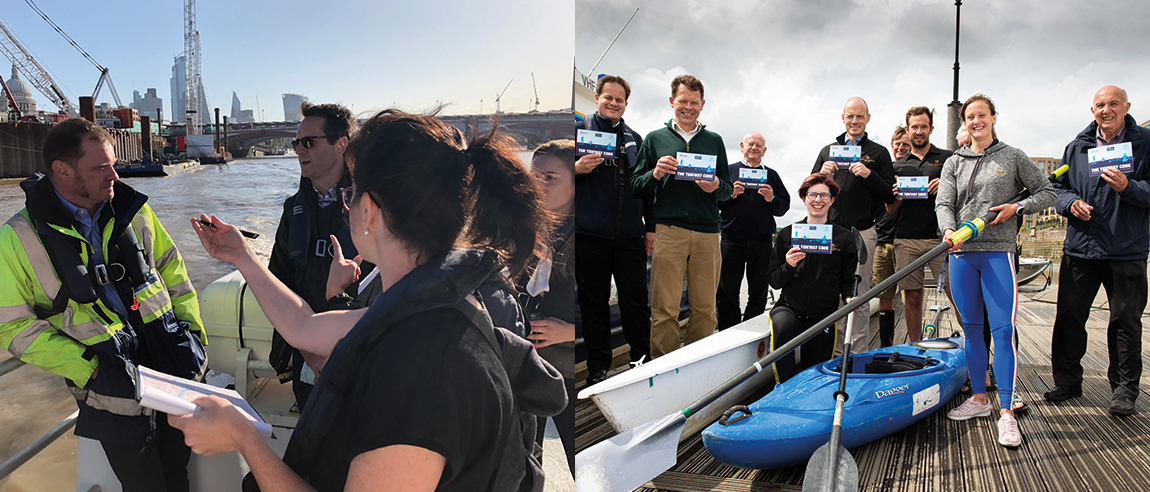
Images: Left: Sharing expertise on a Thames river trip. Right: Launch of the Tideway Code, a combined guide for rowers and paddlers.
|
PLANNING CONSULTATION AND TECHNICAL EXPERTISE
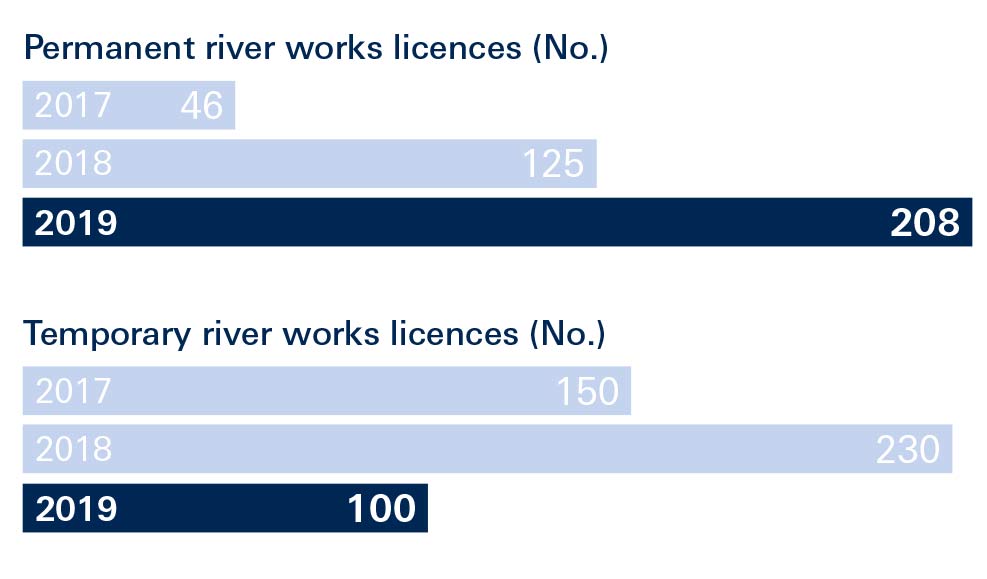 Our planning and technical expertise is at the heart of our work to promote the use of the river. It is widely drawn on as we make sure wharves are maintained and reactivated for port use; provide expert advice to people looking to use the river, whether for trade, travel or leisure; and oversee major events on the Thames.
Our planning and technical expertise is at the heart of our work to promote the use of the river. It is widely drawn on as we make sure wharves are maintained and reactivated for port use; provide expert advice to people looking to use the river, whether for trade, travel or leisure; and oversee major events on the Thames.
As the Thames Tideway Tunnel project reached the halfway point, it continued to rely on the support of our planning and environment team for a timely and efficient licensing service.
The total number of Tideway applications processed in the year was 173 (2018: 248), essentially matching the total number of applications processed for all other river operators.
A similarly focused licensing support approach was provided to Forth Ports’ Tilbury2 project. Their fast-track construction programme commenced within days of the Development Consent Order (DCO) being granted and a robust applications process, that kept pace with their programme, was put in place.
Integrating the river into major infrastructure schemes remained a major focus for the group, with substantial work completed around proposals for the Lower Thames Crossing, ahead of submission to the Planning Inspectorate. We remain particularly concerned that, in spite of forecast long-term growth in port trade, the scheme currently does not include links to key port facilities.
Extensive work was also involved in relation to the Silvertown Crossing. Discussions are now well underway with the RiverLinx consortium which has been appointed to deliver the Silvertown tunnel project.
In July the first phase of bridges in the Illuminated River project were lit (London Bridge, Cannon Street Bridge, Southwark Bridge and the Millennium Footbridge). The PLA was one of myriad authorities licensing activities to enable the project safely to go ahead. We are now discussing the five bridges involved in phase two and expect river works licence applications shortly.
We have been in consultation with Natural England as they investigated how to improve coastal access along a 48-mile stretch of the Kent coast and Thames Estuary between Grain and Woolwich. The proposals were subject to public consultation during 2019 and early in 2020 the Secretary of State at the Department for Environment, Food and Rural Affairs approved those that were not subject to any objections. We will continue to support Natural England as they work to complete the coastal route.
During the year the examination in public of the London Plan Review was completed and a decision on the Mayor’s “Intention to Publish” is expected imminently. The Safeguarded Wharves Review has now been submitted to the Secretary of State, at the Ministry of Housing, Communities & Local Government.
With Royal Wharf Pier now operational, we expect future growth in pier capacity to come as residential development continues to the east of London. At the same time, intensification in river use is likely to result from plans for the new Intercontinental Pier close to the O2 and the proposed Rotherhithe to Canary Wharf electric ferry.
The planning team was involved during the year in numerous other large-scale planning applications falling within the Government’s definition of National Infrastructure Projects. Vattenfall’s proposals for extending its Thanet Offshore Wind Farm in Kent was one such scheme. We convened a cross-PLA group to work with river operators in responding to the proposal to add up to 34 turbines on the edges of the existing wind farm. Together we made the case at the public inquiry that the proposed extension presented significant safety, economic and operational concerns. The outcome of the inquiry is awaited.
We also joined the hearings into Cory Riverside Energy’s DCO application to the Planning Inspectorate to develop its Belvedere Riverside Energy Park project, which would feature technologies including waste energy recovery, anaerobic digestion (of food and green waste), solar panels and battery storage.
BRINGING PEOPLE TOGETHER AND PROMOTING THE RIVER

The river is a hub of activity, whether for trade, travel and sports, and a catalyst for investment. At the PLA we are uniquely placed to be river advocate and convener for those interested in its use and development. This sees us continually developing new partnerships, bolstering established ones and showcasing the river in its broadest sense.
The Thames Vision is a key part of our work in this area. It is a development framework for the river which crosses administrative boundaries and enables us to advocate so that the Thames’ full potential is recognised and embraced.
The Vision was launched in July 2016, after 18 months of development with stakeholders. With substantial changes since then across the city region, increased environmental focus, evolution in river use and logistics, the Vision needs to be reviewed and updated. We have therefore strengthened the team ready to embark on a fresh stakeholder consultation through 2020.
In December we were amongst the first to meet the new Thames Estuary Envoy and have subsequently joined the Thames Estuary Growth Board, ensuring that the river is truly at the heart of the development programme.
The Thames & London Waterways Forum is key to achieving a range of Thames Vision targets, through working groups on passenger transport, freight development and people and places. We convened the Forum’s annual stakeholder meeting in October hosted by London’s deputy Mayor for transport, Heidi Alexander. The new, discussion style format enabled stakeholders to hear about the latest river developments and engage in debate across freight, travel and skills development.
The Port of London Infrastructure Group proves to be a continually useful forum, bringing together major terminal operators with politicians, Government officials and the major infrastructure providers. Together they share the challenges in bridging the gap between the port trade growth forecasts in the Thames Vision and the infrastructure needed to sustain the increased tonnages.
Two years after the launch of the Vision, it had become obvious that we needed to bolster resources to achieve the goal of increasing participation in sport and recreation. We consequently appointed a sports participation and community outreach manager, who is now leading our engagement with clubs along the river, Sport England, London Sport, the National Governing Bodies for canoeing, rowing and sailing, Thames Regional Rowing Council and others. She leads on our two sports promotion groups and is working particularly closely with London Sport on a new initiative, Active Thames.
September 2019 saw the culmination of a great deal of work by us, in partnership with the Greater London Authority (GLA) and other stakeholders, when The Case for a Cultural Vision for the Thames was published. The publication sets out how clear direction and collaboration can make the most of the river’s cultural attractions, for the benefit of Londoners and visitors alike. It aligns with GLA’s priorities for promoting the city on the world stage and the Thames Vision.
ENVIRONMENTAL STEWARDSHIP

We conserve and enhance a range of diverse, thriving habitats for many different species of fish, birds, seals and other wildlife alongside the thriving commercial port and river activities. Increasingly we are known for our industry-leading work in improving air quality on the Thames.
The environment agenda being addressed by our team has broadened progressively over recent years to embrace air quality, carbon emissions, habitats and water quality. In response, the team working on environmental stewardship has been expanded, to include technical advisors in areas such as water quality, biodiversity and environmental protection. This bolstered resource will support achievement of the environmental goals in the Thames Vision.
We started work in 2019 to develop our approach to the Net Zero agenda. This will be a major focus for us through 2020 and into 2021, as we assess Net Zero and how to achieve it, for both the PLA and the port as a whole.
Late in 2019 we took delivery of the new hybrid pilot cutter, Leader, which will return a marked reduction in our carbon footprint for the year. Our 2019 performance does not reflect the benefits of Leader’s introduction: our carbon generation was 1,916 CO2 equivalent tonnes, down on the 2018 figure of 2,042 CO2 equivalent tonnes.
2019 saw a continued focus on delivery of the actions in the Air Quality Strategy for the tidal Thames. Key amongst these was the ‘Greening Inland Shipping Conference’ which we convened during London International Shipping Week. The event took an in-depth look at the new fuels and technologies which are reducing emissions from inland vessels and addressed how they might be adopted on the Thames.
Further Air Quality Strategy work includes air quality monitoring at Greenwich to assess the impact of cruise ships mooring midstream in the Thames and commissioning of a ‘road map exercise’ to assess the practicalities of employing different propulsion and fuel solutions on the river. A revision currently being created which aligns with the Government’s Clean Air Strategy actions, for which a PLA secondee helped to develop Guidance for Ports.
Effective delivery of the Strategy will rely on partnership working across industry, local authorities and Government. The Mayor’s Air Quality Fund provided £500,000 for the grant scheme, Clean Air Thames, which launched at Greening Inland Shipping. This supports the adoption of cleaner vessel technology and is a welcome catalyst for progress. Administered by the Cross River Partnership, with the PLA on its board, it will support the retrofit up to eleven river vessels, with the aim of cutting their emissions by up to 90%.
Our work to drive improvements in air quality is supported by the ‘green’ discount for environmentally cleaner ships calling on the Thames. Launched in 2017, this incentive has been progressively enhanced, with a doubling of the discount on main port charges to 10% in 2019. In 2020 this has been further enhanced, with tiered incentives: 20% discount for vessels with an Environmental Ship Index score of 50 and above, and the 10% discount remaining for vessels scoring 30-plus. More than £200,000 worth of discounts have been made since the scheme started.
Last year, 241 vessels achieving the required Environmental Ships Index standard to qualify for the discount called on the Thames, up from 209 in 2018. The cleaner vessels visited the port a total of 925 times, up from 418 in the previous 12 months.
The Thames Estuary contains significant and protected wetland habitats, supporting a wide range of flora and fauna, including many species that are in decline or under threat. During the year we started work with the RSPB to improve designated sites in South Essex, in line with goals in the Thames Vision. Species set to benefit from the £150,000 plus investment include the rare shrill carder bee, and important birds like the lapwing and redshank.
In total the partnership will protect and improve the condition of 386 hectares of priority habitat and 10 km of enhanced wetland ditches to support water voles and dragonflies. It will also provide new connections between areas of habitat allowing species to access them. PLA staff helped with the habitat work in four days volunteering on the sites to clear habitats ready for the birds and bees.
Partnership working remains key and continued throughout 2019. With the Environment Agency and Thames Estuary Partnership, we delivered a new Estuary Edges website, providing updated guidance for planners and developers on enhancing riverside public open space along the Thames, for people and wildlife.
The Thames Litter Forum, which the PLA chairs, continues to work on delivery of the Thames Litter Strategy. Launched in 2018, the Strategy is now subject to its first review working out the best way to measure and deal with litter in the river and on the foreshore. The recovery by one of our driftwood teams of 70 shopping trollies from a single Thames-side site in one day underlines the continuing importance of this work.
PLA IN THE COMMUNITY

As a Trust Port, we look after the river for the benefit of many stakeholders and, ultimately, future generations. We are active members of the river and wider communities, generating benefits well beyond those of our core operations. Activity on the river generates Gross Value Added of more than £6 billion annually and supports in excess of 140,000 jobs across port and other operations, tourism and recreation.
Through payments including wages, taxes, supplies bought in and charitable donations our operations generate substantial stakeholder benefits. We calculate this totalled £41 million in 2019 (2018: £36.7 million).
Our discretionary spend on projects and partnerships that directly support charitable and stakeholder goals in the year amounted to more than £1 million. Through our Investment Plan, our goal is to invest for return and growth so that we are able to sustain and potentially increase this support and outreach in the future.
Our biggest single community investment in 2019 was the £500,000 project to repaint Richmond Lock & Weir as we marked 125 years since it opened. The project involved extensive scaffolding to enable the application of 3,500 litres of paint, carefully sourced to meet English Heritage specifications.
We continue to develop our existing partnerships as we work to deliver the goals of the Thames Vision.
Our support for Tilbury Seafarers Centre continues, both through our long term annual grant to the centre and in kind support. In a now established tradition, the run up to Christmas saw PLA employees visit the Centre to wrap gifts of essentials for seafarers who call on the Thames through the festive period.
During 2019 we confirmed our intent to work with the Museum of London Docklands on a six-month exhibition in 2021, showcasing unique artefacts drawn from our archive which is held at the Museum. Additional archivists were recruited during the year for a programme of accelerated archiving to identify materials for the exhibition.
We are now established as a major supporter of the Thames Festival Trust’s Totally Thames event, held every September. Complementing this is our long-term involvement with the Trust’s Thames Lens photographic competition, which produces exceptional images of the river; some of this year’s leading entries appear in this report.
In education we have a mixed programme across Thames Festival Trust’s Rivers of the World education programme in East London schools, London Youth Rowing’s ‘Breaking Barriers’ campaign and Thames Explorer Trust’s delivery of lessons in schools along the river.
One of the Thames Vision goals is to encourage greater sport and recreation on the river. In line with this we made the first Sports Participation Fund grants in 2019. Beneficiaries included: Dartford Cambria Sea Scouts, with funding for new sailing dinghies; Gravesend Regatta Society, a safety boat and new lifejackets; Alexandra Yacht Club in Southend-on-Sea; the AHOY Centre in Deptford; Twickenham Yacht Club; and the Third Osterley Sea Scouts.
Among our ad hoc community support was a joint initiative with Canal & River Trust which enabled Dutch Sea Cadet Corps ship Rigel to visit the Dockland Scout Project at West India Dock, where Rigel’s sister ship Lord Amory is based. The Cadets were only able to make the trip after the PLA and the Trust waived pilotage, mooring and berthing fees.
Our match funding for employees’ fund-raising efforts continued in 2019. These included donations to Gravesend Rowing Club and Gravesend Fixed Seat Rowing Club matching money raised in a Biathlon race staged by employees, and for Anne Cromie who ran the Brighton Marathon for Cancer Research UK.

Images: Left: Our annual employee survey showed improved levels of staff engagement. Right: Graduation for pupils from St Angela's Ursuline School who we worked with as part of the London Youth Rowing Breaking Barriers Programme.
|
PLA PEOPLE
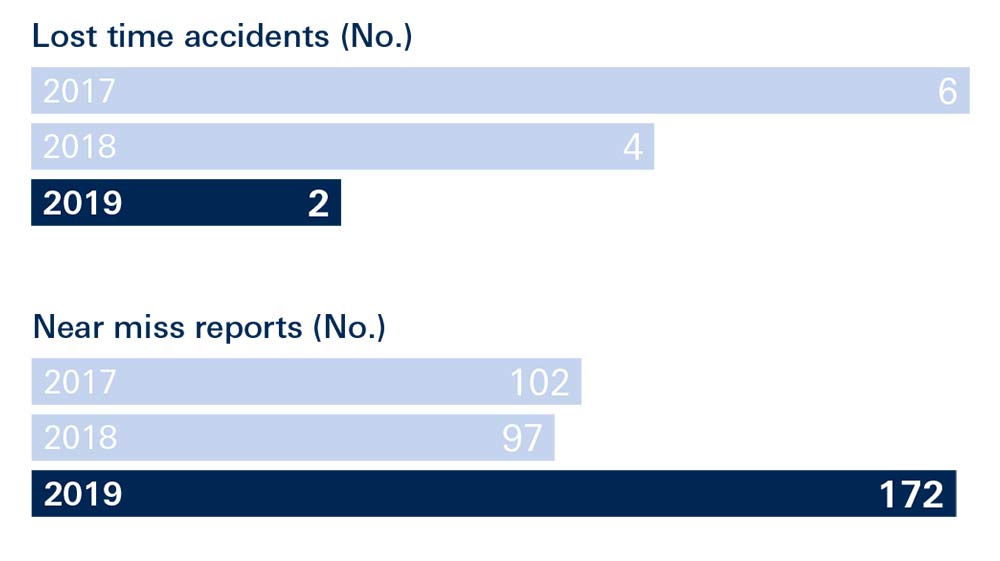
Our 401 employees keep the UK’s supply chains flowing and enable millions of people to enjoy the UK’s busiest tidal river safely every year. The team’s seafaring and marine expertise is complemented by specialist electrical and marine engineers, planners, civil engineers, hydrographers, environmental and many other experts.
In response to the evolving demands on the PLA and changing uses of the river, we undertook a thorough review of our operations in 2019 and developed a new People Strategy. The Strategy, which is now being implemented, features adding resource in areas of growing and greater demand, principally our pilotage, environment and Thames Vision teams.
The People Strategy features a strong commitment to diversity. We are striving to deliver diverse shortlists for vacancies, to ensure that, over the long term, our workforce better represents the communities we serve. We have also joined the organisation Inclusive Employers who support organisations looking to build inclusive workplaces. In early 2020 they have delivered workshops Making Inclusion an Everyday Reality, reaching all employees.
Progressive reviews and restructuring of teams continued across the business, enhancing skills and capabilities, and moves to improve cross-team working. Supporting this is the refurbishment of our main Gravesend office to provide more modern, flexible working space.
The health, safety and wellbeing of our workforce was a key focus once again. A major push on Near Miss reporting early in 2019 resulted in a record 172 reports, up from 97 in 2018. The total number of incidents in the year was 29 (down from 41 in 2018). Of these, two were reportable Lost Time Accidents (2018: 4).
The appointment of a new head of health, safety and wellbeing saw a revised Health, Safety & Wellbeing Strategy adopted. This included a Health and Wellbeing Week featuring mindfulness, pilates and comedy sessions, to illustrate mental health issues, and throw line training. A new behavioural training intervention is being developed as a core part of new staff induction, as well as being rolled out to existing staff members.
As part of our work to support greater diversity in the workplace, we have contracted with a safety/workwear supplier who provide Personal Protective Equipment specifically designed for women.
We track staff engagement in the business through an annual employee survey. The 2019 score of 77/100, improved from 74/100 in 2018. The survey results continue to show strong pride working for the PLA, with recognition of the good working environment and commitment to Health & Safety. Communications between teams remains an issue and we have committed to improving internal communications and providing more opportunities for feedback, with regular Team Talks and plans for a weekly email to promptly share key information more effectively.
We participated in the annual Thames Sail Barge race, sailing in the Sea Change Trust’s Blue Mermaid, the construction of which the PLA partially funded.
PLA ACTIVITY INDICATORS
PORT TRADE STATISTICS
REVIEW OF PRINCIPAL RISKS
This statement captures the collective view of the Board and Executive Committee of the principal risks that the PLA works to manage. The key risks have a broad spread across safety, operational, economic aspects; new additions to the catalogue are around coronavirus, cyber security and climate change. Reputational risk is not given a separate listing; it is inherent in failing adequately to deal with the key risks identified here.
CORONAVIRUS (NEW ADDITION)
The outbreak of the coronavirus, and the unprecedented steps being taken around the world in response, is a major new risk for the PLA. The potential impact runs across the business, from personal health & safety to operational resilience, and, as economic activity largely goes on hold for an indeterminate period, the viability of some of our customers and the long-term health of our finances. Mitigating steps include early adoption of social distancing to help prevent the spread of the disease, curtailing and delaying non-essential expenditure and continued close customer liaison as part of horizon scanning.
We have looked at the financial resilience of our business and have put in place measures to monitor and mitigate the risks as they are developing.
SAFETY
Numerous mitigating systems are in place on the river, including an effective navigational Safety Management System (SMS), risk assessment/hazard reviews, Vessel Traffic Services (VTS), pilotage, hydrography, Passenger Boat Code of Practice, Automatic Identification System (AIS), RNLI and London Coastguard, special signal lights and speed control byelaws. The PLA also hosts safety orientated initiatives such as seminars and works closely with security services.
In the context of growing volumes of river traffic, the continued trading of historic passenger boats, with the risk of significant loss of loss of life if one of these vessels was involved in a collision and foundered, is an increasing concern. We strongly endorsed the Maritime & Coastguard Agency consultation and support proposals to amend the technical requirements for older Domestic Passenger Vessels to be more comparable with modern regulations.
Personal Health & Safety is a priority in the business, managed through personal responsibility, our Golden Rules – Care, Challenge and Comply – and our safety management system.
OPERATIONAL
The most significant operational risk to the PLA would be the closure or partial closure of the port, significantly disrupting or halting operations and trade. There are a number of possible causes including, but not limited, to:
-
collision;
-
grounding;
-
foundering;
-
deliberate terrorist / pressure group action; and
-
significant cyber security incident.
Mitigations include effective navigational SMS, risk assessment/ hazard review, VTS, pilotage, and hydrography. Historically, the PLA has demonstrated an effective response to clearing navigational channels if engaged to do so, with experience highlighting the Marine Services team and the vessel London Titan as key to this capability. We also participate in the Thames Security Forum and resilience groups.
ECONOMIC
A fundamental shift in the micro or macro financial environment in which the PLA operates has the greatest potential to impact the Port of London in general and the PLA’s finances in particular. This includes anything from changes in trade such as business cessation of a major customer or change in the consumer market, through to national or international economic factors such as a change in global trading patterns, or changes resulting from Brexit.
Communication channels are in place with a view to anticipating any such change in sufficient time to react accordingly by making a corresponding shift in our cost base. Debt management protocols are in place and international exposure is minimised as far as is possible. Five-year business plans as well as an annual forecast and budget exercise are undertaken.
FINANCIAL
Post 2019, the coronavirus has presented a challenge to all businesses; we have prepared detailed sensitivity analysis and financial scenarios looking at the potential impact on our cashflow, extending out to the next 12 months. We have put in place a bad debt review process. As a mitigation, we have assessed the government business interruption financial assistance packages and job retention schemes and we do have sufficient assets we can borrow against, if needed.
Following the latest triennial valuation there continues to be a substantial deficit on an actuarial basis on the PLA Pension Fund of £64.4 million. Whilst this is a significant sum, an agreed deficit repair plan is in place with the trustees.
For the short and medium term, changes have been implemented to the pension scheme benefits structure, including the switch to career average as the basis for benefit calculation, longer term the PLA are investigating the launch of a new defined contribution scheme for new starters from January 2022.
The Pilots National Pension Fund, a multi-employer scheme, also has a substantial deficit in which the PLA has a share in the region of 6.8%. It is a long-term open-ended industry-wide liability over which individual employers have little influence. An industry-wide repair plan is in place which, in common with many ports, is funded by way of a levy.
SIGNIFICANT CYBER SECURITY INCIDENT (NEW ADDITION)
All businesses face the possibility of a successful cyber security breach. Threats can vary in their complexity and sophistication and can potentially negatively impact organisations of all sizes. We deploy a range of industry-standard security products, both internally and on our network perimeters. Formal security and IT conditions of use policies are established, which define security standards and acceptable use. Office-based staff receive security awareness training and guidance on detecting ‘phishing’ and other malicious emails and we continue to enhance data governance processes including formalised data retention and classification policies.
CLIMATE CHANGE (NEW ADDITION)
Climate change is a subject with which we have been engaged for a number of years, but it is now viewed as one of the principal risks to which the PLA has to respond.
As a port handling more than 10 million tonnes of cargo, we completed a risk assessment and submitted our first climate change adaptation report to Defra under the Climate Change Act in 2011. The risk assessment was updated, and a second adaptation report submitted in 2015. It will be updated again – in the light of subsequent experience – for the third report, which we will be preparing for submission in 2020.
In responding to climate change, the UK Government has made a legally binding commitment to achieving a Net Zero Carbon economy by 2050. This will result in wholesale change across the economy and the ports that serve it. For the PLA major changes that are likely, or potentially likely, to result include: the long term reduction in tonnages of oil related cargos (currently representing around a quarter of port trade and a major source of income); development of new “green” cargoes; existing vessels’ propulsion systems becoming obsolete; need to adopt new technologies; dealing with unforeseen legislative changes; and managing the impact of extreme weather on the business.
In managing this risk, the PLA has established a major project to develop plans for a Net Zero PLA and a Net Zero Port, which will run through 2020 and 2021.
LONG TERM VIABILITY STATEMENT
The Board has assessed the viability of the company over a five-year period to December 2024, taking account of the company’s current position and potential impact of the principal risks documented in the corporate risk register. The five-year review period was selected for the following reasons:
I. A five-year financial plan is presented to the Board for approval on an annual basis. To go beyond that in a business environment prone to change has in the past proved unrealistic. The recent rapid growth in vessel size is indicative of this.
II. With a balance sheet dominated by pension liabilities it makes sense for us to use a review window which does not extend far beyond the triennial valuation process of the PLA Pension Fund and PNPF.
Scenarios considered include the impact of Brexit, but more immediate is the impact of coronavirus. We have assessed a 30% downturn in our business over the next 12 months, the levels of bad debt which may result and the ability of the organisation to utilise the Government’s financial assistance schemes, as well as the impact on the pension suffering such a major downturn in the global economy.
Based on the results of this analysis, the Board has a reasonable expectation that the company will be able to continue in operation and meet its liabilities as they fall due over the period to December 2024.
In making this statement the Board has considered the resilience of the company, taking account of its current position, the principal risks facing the business in severe but realistic scenarios and the effectiveness of any mitigating actions. This assessment has considered the potential impacts of these risks on the business model, future performance, solvency and liquidity over the period.
Contents: Overview | Strategic Report | Business Model | Performance | Governance | Financial Statements | PDF format
GOVERNANCE
CORPORATE GOVERNANCE REPORT
OUR YEAR
During 2019, the Board focussed the organisation on the following priority areas: the environment, Harbour Revision Order, investment, pricing, health, safety and wellbeing, pensions, people, Gravesend accommodation and significant risk. The board met seven times, with two of the meetings taking place offsite, which provided an opportunity for looking at items in greater depth.
The substantive items we addressed together at the Board included:
-
Thames Vision
-
Investment opportunities
-
People plan
-
Pensions strategy
-
Environment priorities
-
Five-year plan and 2020 objectives
-
River logistics strategy
OUR APPROACH
The PLA Board is the duty holder on health and safety and the accountable body for navigational safety under the Port Marine Safety Code (PMSC). Performance is reviewed regularly, with the guidance of our independent designated person, in order to ensure compliance; the Code recommends the appointment of a designated person to provide independent assurance directly to the Board as duty holder.
The Board’s role is to set the strategy for the PLA, ensure its long-term success and create stakeholder value. In particular, we have a duty to manage the tidal river Thames in trust for future generations and to pass it on to our successors in an improved condition. As a provider of essential navigational safety services, we have to ensure that the organisation is efficient and provides customers with cost-effective services. With no shareholders, we are accountable to stakeholders and value their input in shaping the approach and decisions that we take.
We are committed to maintaining the highest standards of corporate governance and follow the Ports Good Governance Guidance and the UK Corporate Governance Code (where appropriate for a statutory organisation).
As the Board, we regularly receive detailed financial and operational information to allow us to monitor the key areas of the business. Senior managers regularly brief us on various aspects of the PLA’s work.
OUR GOVERNANCE STRUCTURE
Seven scheduled Board meetings (including two offsite meetings) were held during the year. In addition, the six committees of the Board overseeing specific elements of the business met and reported back, as needed. The committees are:
-
A Audit Committee
-
L Licensing Committee
-
N Nominations Committee
-
R Remuneration Committee
-
P Pensions Advisory Committee
-
I Investment Committee
-
T Thames Vision Committee
A series of short reports on each of the committees is available after the Board biographies.
OUR PEOPLE
The Board is made up of a chairman, together with seven non-executive and three executive members.
OUR STAKEHOLDERS
Open communication with our stakeholder community is at the heart of our operations. Consistent with Ports Good Governance Guidance, we hold an Annual Stakeholders’ Forum, where stakeholders have an opportunity to meet, hear from and challenge the Executive and Board. A number of open Public Meetings and River User Consultative Forums are held, giving stakeholders further opportunity for dialogue with the PLA.
OUR APPROACH TO RISK
We adopt a prudent approach to the management of risk in the business. This is consistent with our prime role, providing an essential safety service to our customers. We are also a commercial organisation and accept some level of risk as a normal consequence of doing business.
BOARD EFFECTIVENESS REVIEW
During December 2019, an internal Board evaluation was undertaken as part of the board’s review cycle.
We welcome any feedback you may have on this Annual Report – please email comments to
[email protected]
Christopher Rodrigues CBE
Chairman
15 April 2020
BOARD MEMBERS
As at 30 March 2020
COMMITEES
As at 30 March 2020
BOARD EFFECTIVENESS REVIEW
An internal Board evaluation was undertaken during December 2019. The results and subsequent recommendations were discussed at the February 2020 Board meeting.
A | AUDIT COMMITTEE
Met three times
CURRENT MEMBERSHIP
Judith Armitt (chair), Helen Deeble, Paula Carter
COMMENTARY
The audit committee’s role is to:
-
advise on the appointment/re-appointment/removal of auditors, their terms of engagement and their level of remuneration
-
review the scope and the results of the annual audit and report to the Board on the effectiveness of the audit process
-
review and recommend the annual report and accounts to the Board
-
monitor the internal and external audit programme and consider the conclusions of audits undertaken
-
review the effectiveness of the risk management system
The principal items discussed during the year were around:
-
annual report and accounts
-
treasury policy
-
major project evaluation
-
purchasing review
-
whistleblowing
-
dredging
-
pensions
-
bad debts
-
IT and cyber security
-
legal cases
-
audit of HR and payroll
-
risk process
-
Lloyds Register audit
-
three-year audit schedule
L | LICENSING COMMITTEE
Met four times
CURRENT MEMBERSHIP
Alun Griffiths (chair), Robin Mortimer, Robert Baker, Ian Moncrieff, Darren James
COMMENTARY
The licensing committee’s role is to:
-
approve the processes for administration of the licensing of works
-
determine any application considered contentious or significant
-
determine any proposal to suspend or revoke a licence, take enforcement action or impose a condition contentious or significant
-
approve the granting and appropriate terms, excluding financial, of any leases of PLA land
-
approve the use of powers under the Town & Country Planning (General Permitted Development) Order
The principal items discussed during the year included:
-
mediation
-
enforcement
-
modernisation of the licensing process
-
Harbour Revision Order
-
Thames Tideway Tunnel, Tilbury2 consenting works and London Gateway
-
various licence applications
-
alleged breeches of licence conditions and subsequent action
N | NOMINATIONS COMMITTEE
Met twice
CURRENT MEMBERSHIP
Christopher Rodrigues (chair); Alun Griffiths, additional nonexecutive director, if required
COMMENTARY
The nominations committee’s role is to:
-
recommend to the Board the appointment and reappointment of non-executive directors
-
advise on the expertise required when a vacancy arises
-
recommend to the Board the appointment of a deputy chair
The principal items discussed during 2019 were:
-
the current board skills matrix
-
non-executive director terms
-
reappointment
-
upcoming appointments
-
job descriptions
-
succession
R | REMUNERATION COMMITTEE
Met four times
CURRENT MEMBERSHIP
Annette Malm Justad (chair), Alun Griffiths, Christopher Rodrigues
COMMENTARY
The remuneration committee’s role is to:
-
consider and recommend to the Board the remuneration terms for the organisation, including executive and non-executive directors
-
succession planning of directors and the senior management team
The principal items discussed during the year were around:
-
performance incentive payment scheme
-
executive director performance
-
review of senior grades
-
PLA pay and pensions strategy
-
succession planning
-
people strategy
P | PENSIONS ADVISORY COMMITTEE
Met once
CURRENT MEMBERSHIP
Christopher Rodrigues (chair), Darren James, Annette Malm Justad, Judith Armitt, Robin Mortimer
COMMENTARY
The pensions advisory committee’s role is to:
-
formalise the Board response to Pension Fund decisions
-
monitor pension developments and policy in the wider employment market
-
negotiate any payment plans with pension scheme trustees
The principal items discussed during the year were:
-
actuarial valuation
-
pensions strategy
I | INVESTMENT COMMITTEE
Met three times
CURRENT MEMBERSHIP
Darren James (chair), Christopher Rodrigues, Judith Armitt, Robin Mortimer
COMMENTARY
The investment committee’s role is to:
review investment proposals and make recommendations to the Board
monitor the PLA’s investment strategy
carry out post implementation reviews
The principal items discussed during 2019 were:
-
investment proposals
-
future opportunities
-
current investments
T | THAMES VISION COMMITTEE
Met five times
CURRENT MEMBERSHIP
Paula Carter (chair), Christopher Rodrigues, Judith Armitt, Robin Mortimer
COMMENTARY
The Thames Vision committee’s role is to:
-
review the strategic approach for delivering and measuring progress on the Thames Vision
-
consider priority actions to deliver the Thames Vision linking to the PLA’s business plan
-
review progress and action on Vision goals
The principal items discussed during 2019 were:
-
priority actions
-
progress and planning
-
sports development
-
resourcing
-
Great River Cities of the World Symposium
-
passenger transport
-
environment vision
-
Thames visitor website
-
investments
-
Thames Vision refresh
Contents: Overview | Strategic Report | Business Model | Performance | Governance | Financial Statements | PDF format
FINANCIAL STATEMENTS
Contents: Overview | Strategic Report | Business Model | Performance | Governance | Financial Statements | PDF format
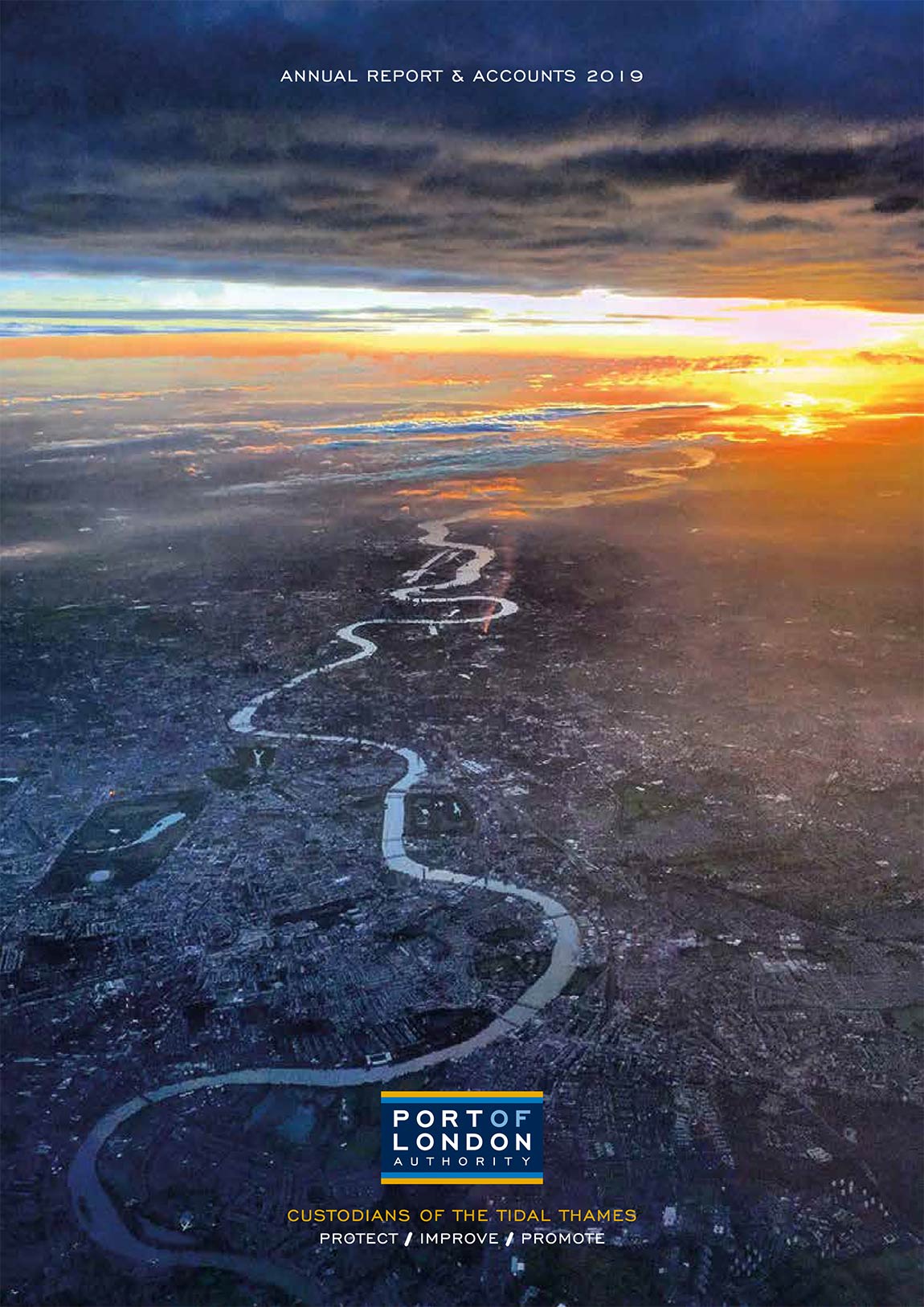

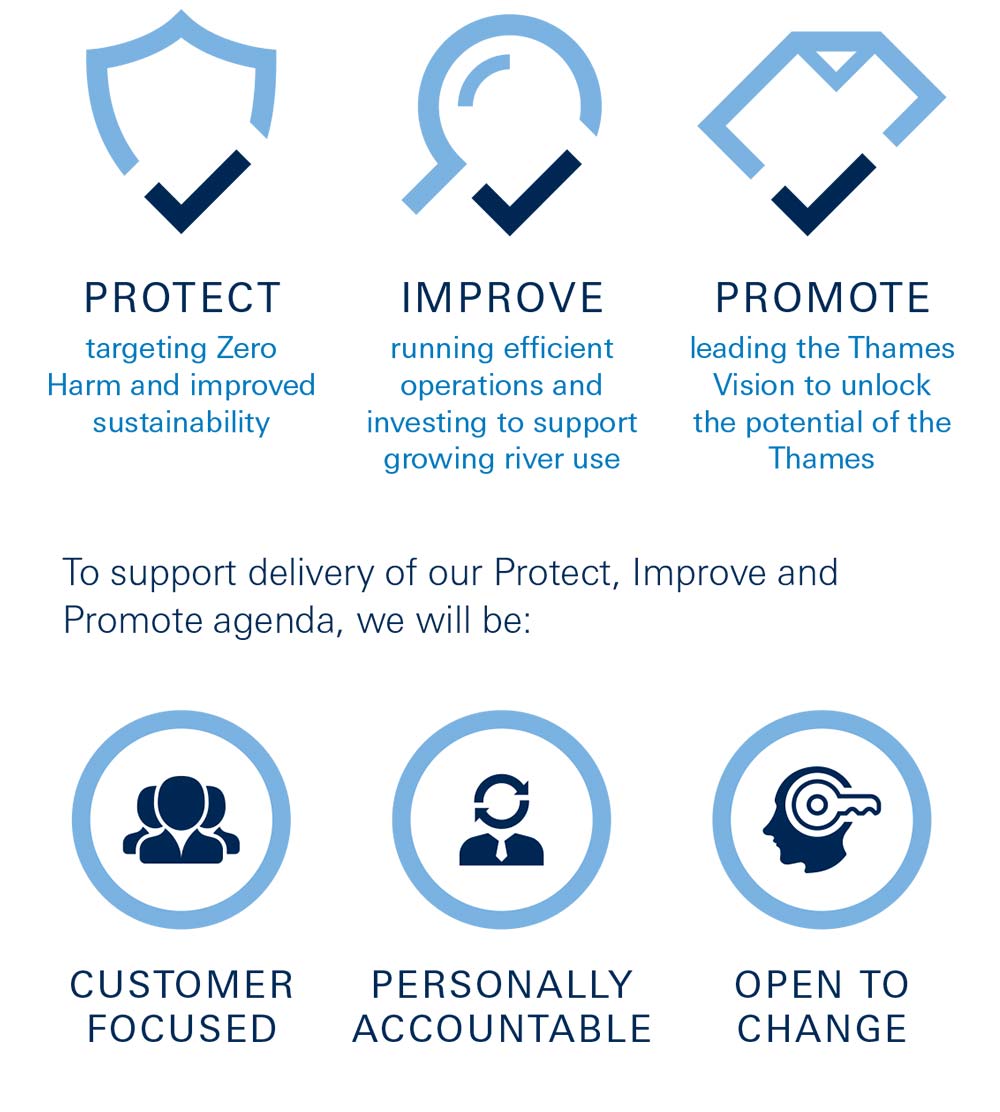
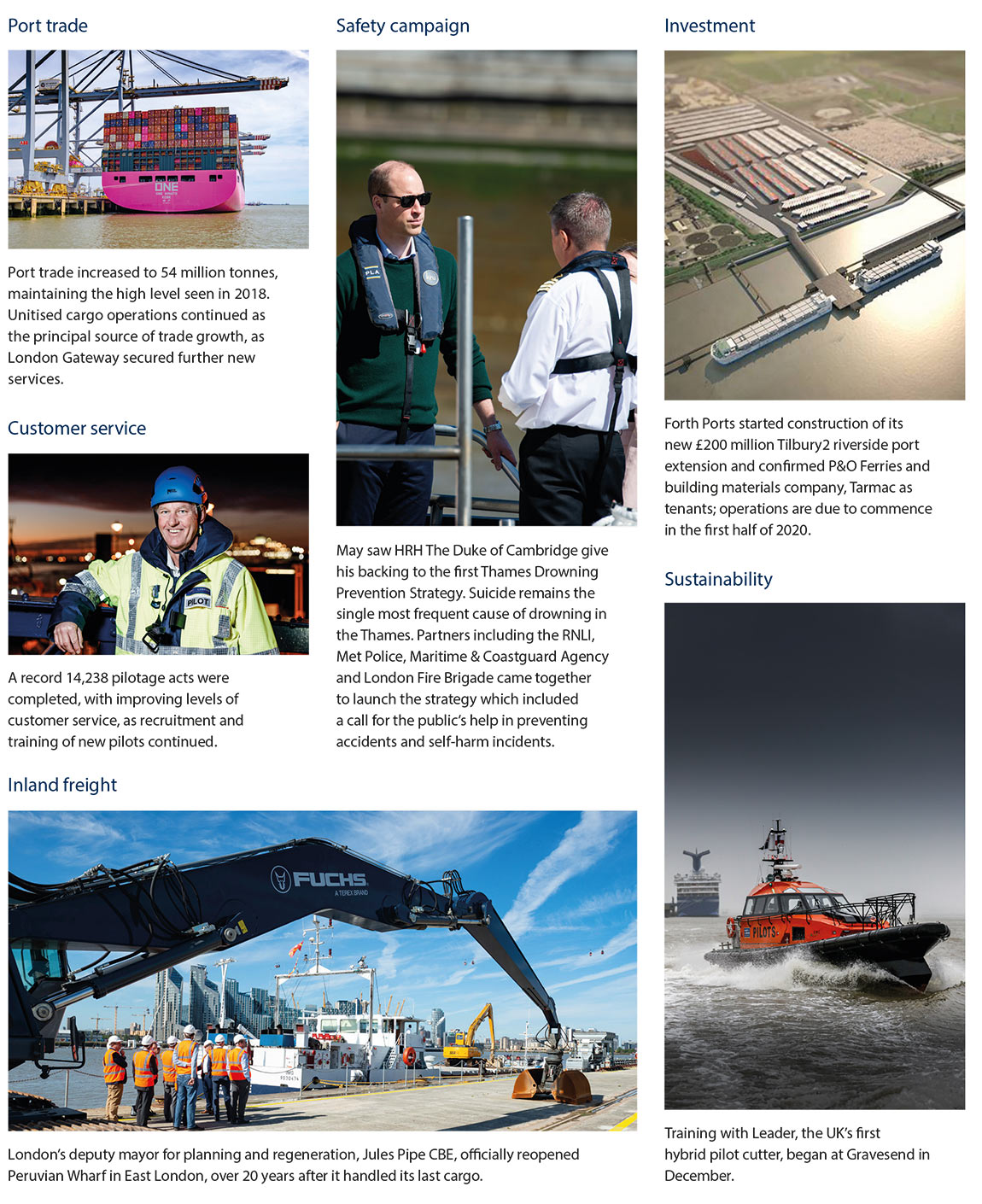
 Chairman Christopher Rodrigues CBE
Chairman Christopher Rodrigues CBE
 Chief Executive Robin Mortimer
Chief Executive Robin Mortimer
 Chief Harbour Master Bob Baker
Chief Harbour Master Bob Baker 2019 saw a record 14,238 pilotage acts (2018: 13,372). This reflected continued growth in trade, particularly again at London Gateway as they secured new services.
2019 saw a record 14,238 pilotage acts (2018: 13,372). This reflected continued growth in trade, particularly again at London Gateway as they secured new services.  Chief Financial Officer Julie Tankard
Chief Financial Officer Julie Tankard Pilotage income for the year was £25 million (2018: £22.5 million); after costs, pilotage made a small, £0.02 million contribution to the year’s overall operating surplus. For 2020, we have made a further change to charges for larger vessels (365 metres and above) to reflect the higher costs of servicing these vessels, which require two pilots.
Pilotage income for the year was £25 million (2018: £22.5 million); after costs, pilotage made a small, £0.02 million contribution to the year’s overall operating surplus. For 2020, we have made a further change to charges for larger vessels (365 metres and above) to reflect the higher costs of servicing these vessels, which require two pilots.
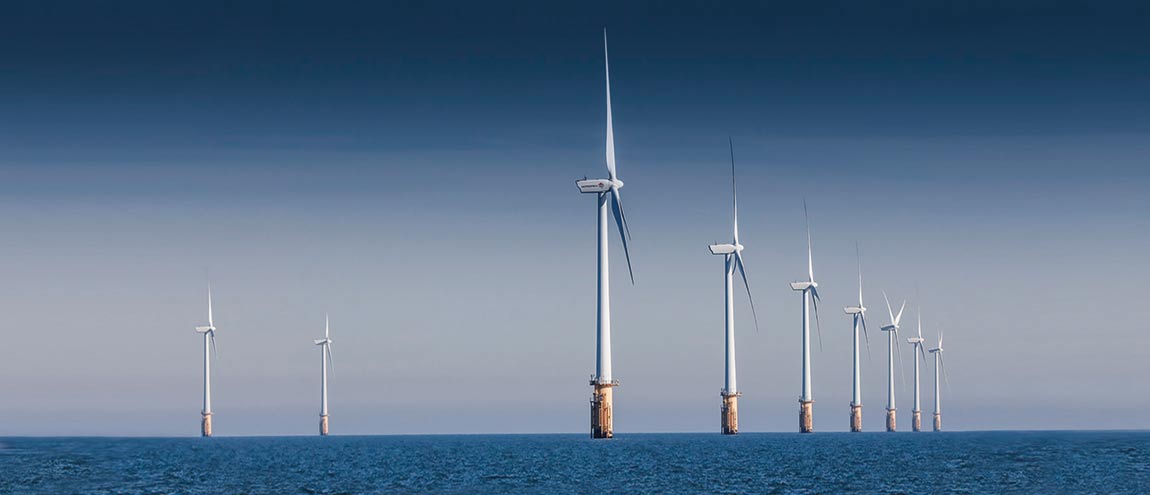
 As a Trust Port, we hold the Thames in trust for future generations. We have no shareholders, so operate for the benefit of customers and stakeholders now and in the future.
As a Trust Port, we hold the Thames in trust for future generations. We have no shareholders, so operate for the benefit of customers and stakeholders now and in the future.
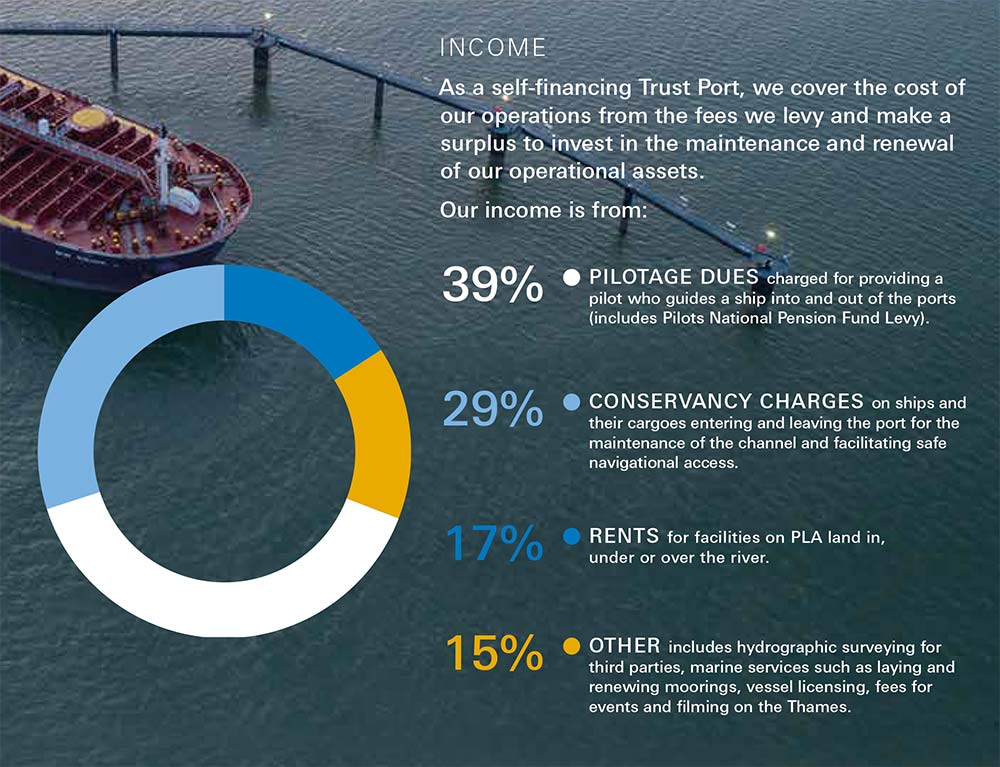

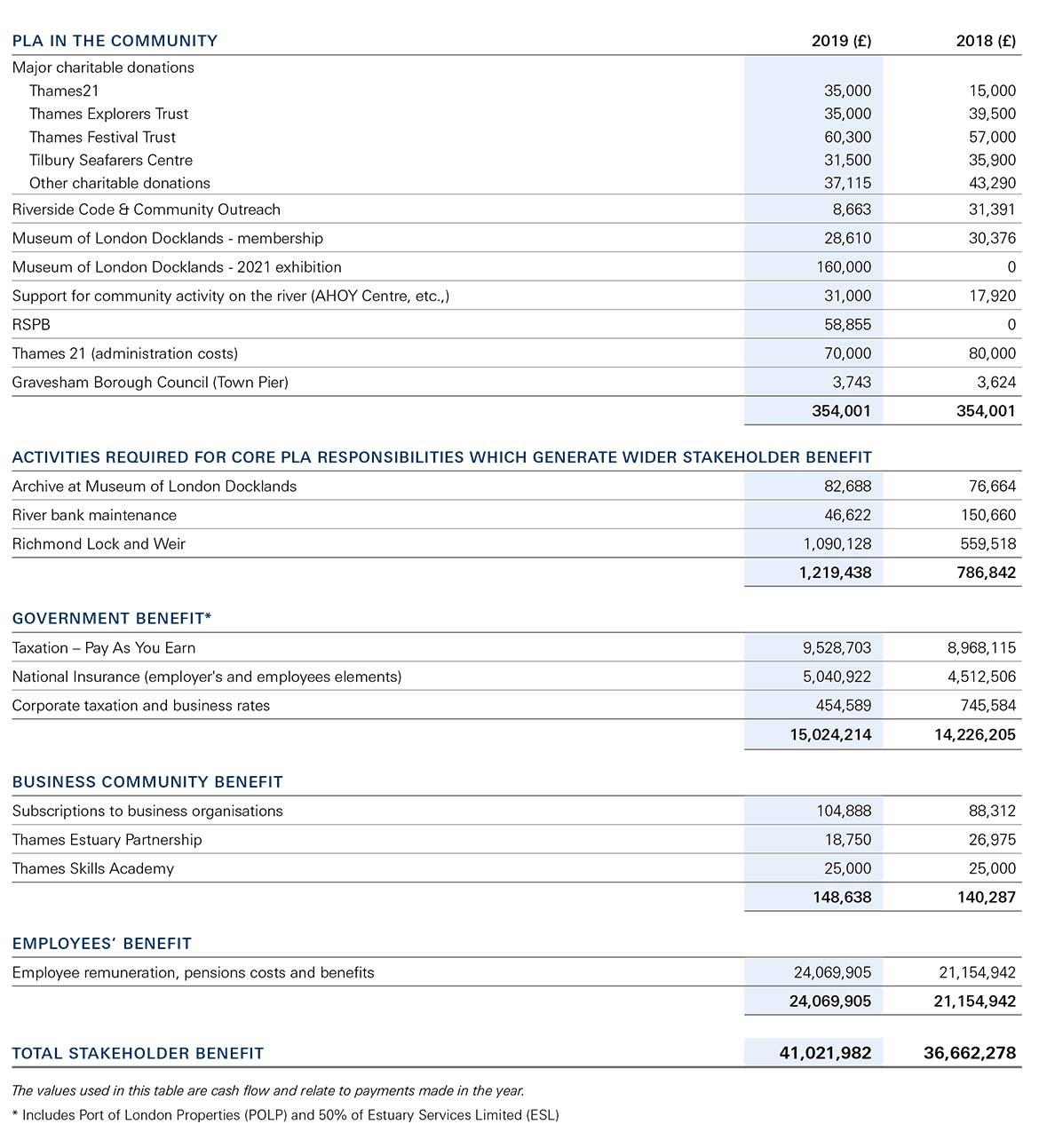
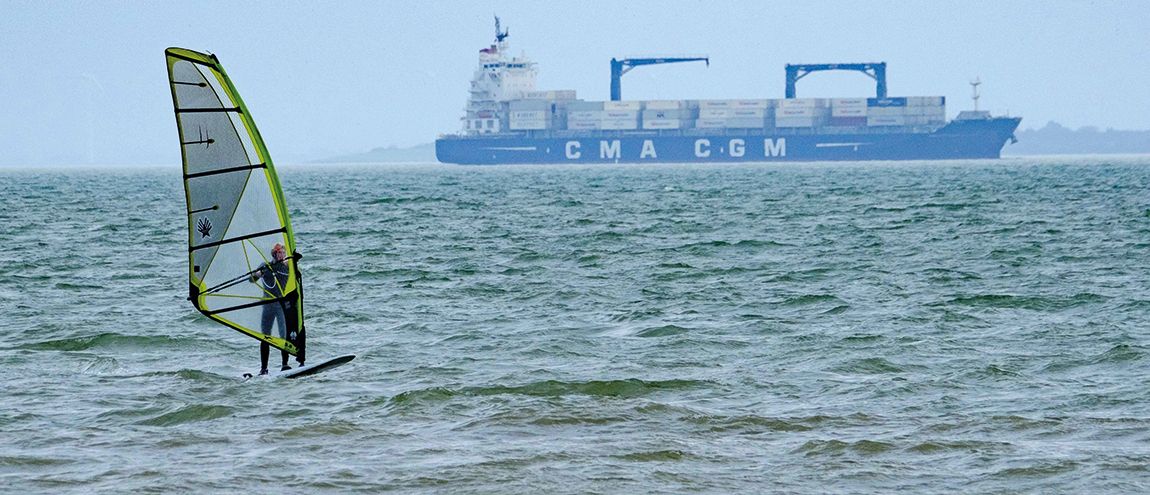
 Trade in the Port of London rose in 2019 to 54 million tonnes from 53.2 million tonnes in 2018. This meant we virtually tied with Grimsby & Immingham as the UK’s leading port in terms of tonnage of goods handled.
Trade in the Port of London rose in 2019 to 54 million tonnes from 53.2 million tonnes in 2018. This meant we virtually tied with Grimsby & Immingham as the UK’s leading port in terms of tonnage of goods handled.  2019 saw 4.79 million tonnes of freight moved between terminals on the Thames, up from 2.63 million tonnes in 2018. The overall tonnage of materials moved increased 82%, as river use by major infrastructure schemes, particularly the Thames Tideway Tunnel, accelerated.
2019 saw 4.79 million tonnes of freight moved between terminals on the Thames, up from 2.63 million tonnes in 2018. The overall tonnage of materials moved increased 82%, as river use by major infrastructure schemes, particularly the Thames Tideway Tunnel, accelerated.  The number of passenger trips on the river remained flat in 2019 at 9.9 million. River tour operations enjoyed some underlying growth, while operational issues affected the Woolwich Ferry service as two new hybrid powered vessels came into service.
The number of passenger trips on the river remained flat in 2019 at 9.9 million. River tour operations enjoyed some underlying growth, while operational issues affected the Woolwich Ferry service as two new hybrid powered vessels came into service.  The number of sporting events held on the river rose again in 2019 to 430, up from 363 in 2018. The increasing number of events reflects growing river use – a key target of the Thames Vision – alongside established marquee events such as the University Boat Races, Head of the River races and the Great River Race.
The number of sporting events held on the river rose again in 2019 to 430, up from 363 in 2018. The increasing number of events reflects growing river use – a key target of the Thames Vision – alongside established marquee events such as the University Boat Races, Head of the River races and the Great River Race.
 Our planning and technical expertise is at the heart of our work to promote the use of the river. It is widely drawn on as we make sure wharves are maintained and reactivated for port use; provide expert advice to people looking to use the river, whether for trade, travel or leisure; and oversee major events on the Thames.
Our planning and technical expertise is at the heart of our work to promote the use of the river. It is widely drawn on as we make sure wharves are maintained and reactivated for port use; provide expert advice to people looking to use the river, whether for trade, travel or leisure; and oversee major events on the Thames. The river is a hub of activity, whether for trade, travel and sports, and a catalyst for investment. At the PLA we are uniquely placed to be river advocate and convener for those interested in its use and development. This sees us continually developing new partnerships, bolstering established ones and showcasing the river in its broadest sense.
The river is a hub of activity, whether for trade, travel and sports, and a catalyst for investment. At the PLA we are uniquely placed to be river advocate and convener for those interested in its use and development. This sees us continually developing new partnerships, bolstering established ones and showcasing the river in its broadest sense.  We conserve and enhance a range of diverse, thriving habitats for many different species of fish, birds, seals and other wildlife alongside the thriving commercial port and river activities. Increasingly we are known for our industry-leading work in improving air quality on the Thames.
We conserve and enhance a range of diverse, thriving habitats for many different species of fish, birds, seals and other wildlife alongside the thriving commercial port and river activities. Increasingly we are known for our industry-leading work in improving air quality on the Thames. As a Trust Port, we look after the river for the benefit of many stakeholders and, ultimately, future generations. We are active members of the river and wider communities, generating benefits well beyond those of our core operations. Activity on the river generates Gross Value Added of more than £6 billion annually and supports in excess of 140,000 jobs across port and other operations, tourism and recreation.
As a Trust Port, we look after the river for the benefit of many stakeholders and, ultimately, future generations. We are active members of the river and wider communities, generating benefits well beyond those of our core operations. Activity on the river generates Gross Value Added of more than £6 billion annually and supports in excess of 140,000 jobs across port and other operations, tourism and recreation.
 Our 401 employees keep the UK’s supply chains flowing and enable millions of people to enjoy the UK’s busiest tidal river safely every year. The team’s seafaring and marine expertise is complemented by specialist electrical and marine engineers, planners, civil engineers, hydrographers, environmental and many other experts.
Our 401 employees keep the UK’s supply chains flowing and enable millions of people to enjoy the UK’s busiest tidal river safely every year. The team’s seafaring and marine expertise is complemented by specialist electrical and marine engineers, planners, civil engineers, hydrographers, environmental and many other experts.